Schneider Electric USA TCSEGWB13FA Protable Battery Powered WiFi Access Point User Manual
Schneider Electric USA Protable Battery Powered WiFi Access Point
User Manual

- I -
TCSEGWB13FA0
Portable Battery Powered WIFI Access
Point

- II -
FCC STATEMENT
This equipment has been tested and found to comply with the limits for a Class B digital device,
pursuant to part 15 of the FCC Rules. These limits are designed to provide reasonable protection
against harmful interference in a residential installation. This equipment generates, uses and can
radiate radio frequency energy and, if not installed and used in accordance with the instructions,
may cause harmful interference to radio communications. However, there is no guarantee that
interference will not occur in a particular installation. If this equipment does cause harmful
interference to radio or television reception, which can be determined by turning the equipment off
and on, the user is encouraged to try to correct the interference by one or more of the following
measures:
Reorient or relocate the receiving antenna.
Increase the separation between the equipment and receiver.
Connect the equipment into an outlet on a circuit different from that to which the receiver
is connected.
Consult the dealer or an experienced radio/ TV technician for help.
This device complies with part 15 of the FCC Rules. Operation is subject to the following two
conditions:
This device may not cause harmful interference.
This device must accept any interference received, including interference that may cause
undesired operation.
Any changes or modifications not expressly approved by the party responsible for compliance
could void the user’s authority to operate the equipment.
Note: The manufacturer is not responsible for any radio or TV interference caused by
unauthorized modifications to this equipment. Such modifications could void the user’s authority
to operate the equipment.
FCC RF Radiation Exposure Statement:
This equipment complies with FCC RF radiation exposure limits set forth for an uncontrolled
environment. This device and its antenna must not be co-located or operating in conjunction with
any other antenna or transmitter.
“To comply with FCC RF exposure compliance requirements, this grant is applicable to only
Mobile Configurations. The antennas used for this transmitter must be installed to provide a

- III -
separation distance of at least 20 cm from all persons and must not be co-located or operating in
conjunction with any other antenna or transmitter.”
CE Mark Warning
This is a class B product. In a domestic environment, this product may cause radio interference, in
which case the user may be required to take adequate measures.
This device has been designed to operate with the antennas listed below, and having a maximum
gain of 3 dBi. Antennas not included in this list or having a gain greater than 3 dBi are strictly
prohibited for use with this device. The required antenna impedance is 50 ohms.
To reduce potential radio interference to other users, the antenna type and its gain should be so
chosen that the equivalent isotropically radiated power (e.i.r.p.) is not more than that permitted for
successful communication.
- IV -
CONTENTS
Package Contents.................................................................................................................................. 1
Chapter 1. Introduction ....................................................................................................................... 2
1.1 Overview of the Router ....................................................................................................... 2
1.2 Conventions ........................................................................................................................ 2
1.3 Main Features ..................................................................................................................... 2
1.4 Panel Layout ....................................................................................................................... 3
1.4.1 The Front Panel ...................................................................................................... 3
1.4.2 The Rear Panel ...................................................................................................... 4
Chapter 2. Connecting the Router ..................................................................................................... 5
2.1 System Requirements ......................................................................................................... 5
2.2 Installation Environment Requirements .............................................................................. 5
Chapter 3. Quick Installation Guide ................................................................................................... 6
3.1 Travel Router (AP) Mode .................................................................................................... 6
3.2 PC configuration.................................................................................................................. 6
3.2.1 Connect to Network ................................................................................................ 7
3.2.2 Router Configuration .............................................................................................. 7
Chapter 4. Configuring the Router .................................................................................................... 8
4.1 Login ................................................................................................................................... 8
4.2 Devices List ......................................................................................................................... 8
4.3 Status .................................................................................................................................. 8
4.4 WPS .................................................................................................................................... 9
4.5 Network .............................................................................................................................10
4.5.1 LAN .......................................................................................................................10
4.6 Wireless ............................................................................................................................ 11
4.6.1 Wireless Settings .................................................................................................. 11
4.6.2 Wireless Security ..................................................................................................13
4.6.3 Wireless MAC Filtering .........................................................................................16
4.6.4 Wireless Advanced ...............................................................................................19
4.6.5 Wireless Statistics .................................................................................................20
- V -
4.7 DHCP ................................................................................................................................21
4.7.1 DHCP Settings ......................................................................................................21
4.7.2 DHCP Clients List .................................................................................................22
4.7.3 Address Reservation ............................................................................................22
4.8 System Tools .....................................................................................................................24
4.8.1 Time Settings ........................................................................................................24
4.8.2 Diagnostic .............................................................................................................26
4.8.3 Firmware Upgrade ................................................................................................28
4.8.4 Factory Defaults....................................................................................................29
4.8.5 Backup & Restore .................................................................................................29
4.8.6 Reboot ..................................................................................................................30
4.8.7 Password ..............................................................................................................31
4.8.8 System Log ...........................................................................................................31
4.8.9 Statistics ................................................................................................................32
Appendix A: FAQ .................................................................................................................................34
Appendix B: Specifications ................................................................................................................36

TCSEGWB13FA0
Portable Battery Powered WIFI Access Point
- 1 -
Package Contents
TCSEGWB13FA0 Portable Battery Powered WIFI Access Point
Power Adapter
Battery
USB Cable
Ethernet cable
Quick Installation Guide
Note:
Make sure that the package contains the above items. If any of the listed items are damaged or
missing, please contact with your distributor.

TCSEGWB13FA0
Portable Battery Powered WIFI Access Point
- 2 -
Chapter 1. Introduction
Thank you for choosing the TCSEGWB13FA0 Portable Battery Powered WIFI Access Point.
1.1 Overview of the Router
TCSEGWB13FA0 from Schneider is a truly wireless networking platform which is able to
broadcast a wireless signal at up to 150Mbps around a room, creating a mobile office or
entertainment network for up to five devices to access the Internet simultaneously. The device is
the ideal travel companion, with pocket-sized dimensions and powered by its own powerful
internal 2000mAh battery, users can work or play for hours on end. The device is also incredibly
easy to use, allowing users to rapidly set up an Internet connected wireless network in as little time
as it takes to plug in their WAN cable and when finished, simply place the device back in their
pockets.
1.2 Conventions
The router or TCSEGWB13FA0 mentioned in this guide stands for TCSEGWB13FA0 Portable Battery
Powered WIFI Access Point without any explanation.
1.3 Main Features
Make use of IEEE 802.11n wireless technology to provide a wireless data rate of up to
150Mbps.
One 10/100M Auto-Negotiation RJ45 WAN port, four 10/100M Auto-Negotiation RJ45 LAN
ports, supporting Auto MDI/MDIX.
Provides WPA/WPA2, WPA-PSK/WPA2-PSK authentication, TKIP/AES encryption security.
Supports AP mode
Supports UPnP, Dynamic DNS, Static Routing.
Built-in NAT and DHCP server supporting static IP address distributing.
Provides 64/128/152-bit WEP encryption security
Supports Flow Statistics.
Supports firmware upgrade and Web management.
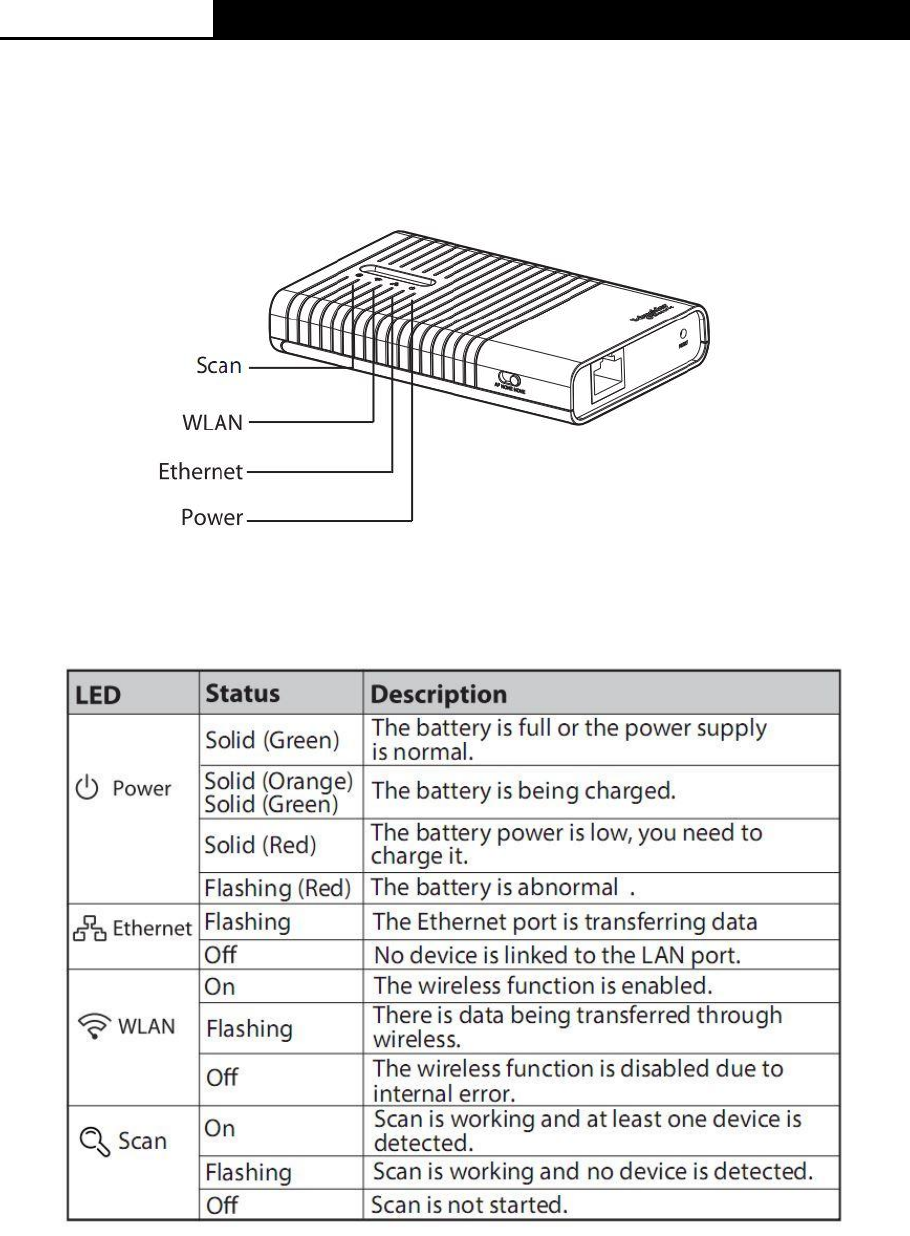
TCSEGWB13FA0
Portable Battery Powered WIFI Access Point
- 3 -
1.4 Panel Layout
1.4.1 The Front Panel
Figure 1-1 Front Panel sketch
The router’s LEDs are located on the front panel (View from bottom to top).
Table 1-1 The LEDs Description
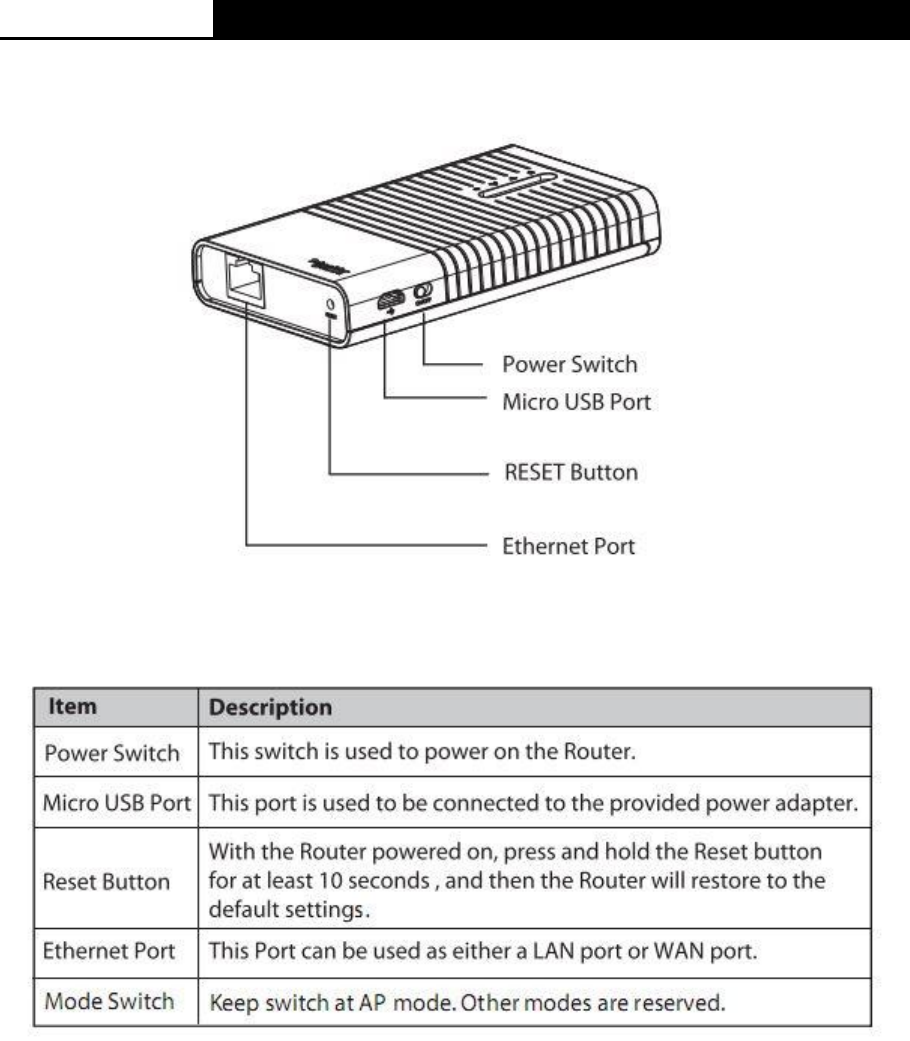
TCSEGWB13FA0
Portable Battery Powered WIFI Access Point
- 4 -
1.4.2 The Rear Panel
Figure 1-2 Rear Panel sketch
The following parts are located on the rear panel (View from left to right).

TCSEGWB13FA0
Portable Battery Powered WIFI Access Point
- 5 -
Chapter 2. Connecting the Router
2.1 System Requirements
Broadband Internet Access Service (DSL/Cable/Ethernet)
One DSL/Cable Modem that has an RJ45 connector (which is not necessary if the Router is
connected directly to the Ethernet.)
PCs with a working Ethernet Adapter and an Ethernet cable with RJ45 connectors
TCP/IP protocol on each PC
Web browser, such as Microsoft Internet Explorer, Mozilla Firefox or Apple Safari
2.2 Installation Environment Requirements
Place the Router in a well ventilated place far from any heater or heating vent
Avoid direct irradiation of any strong light (such as sunlight)
Keep at least 2 inches (5 cm) of clear space around the Router
Operating Temperature: 0℃~40℃ (32℉~104℉)
Operating Humidity: 10%~90%RH, Non-condensing
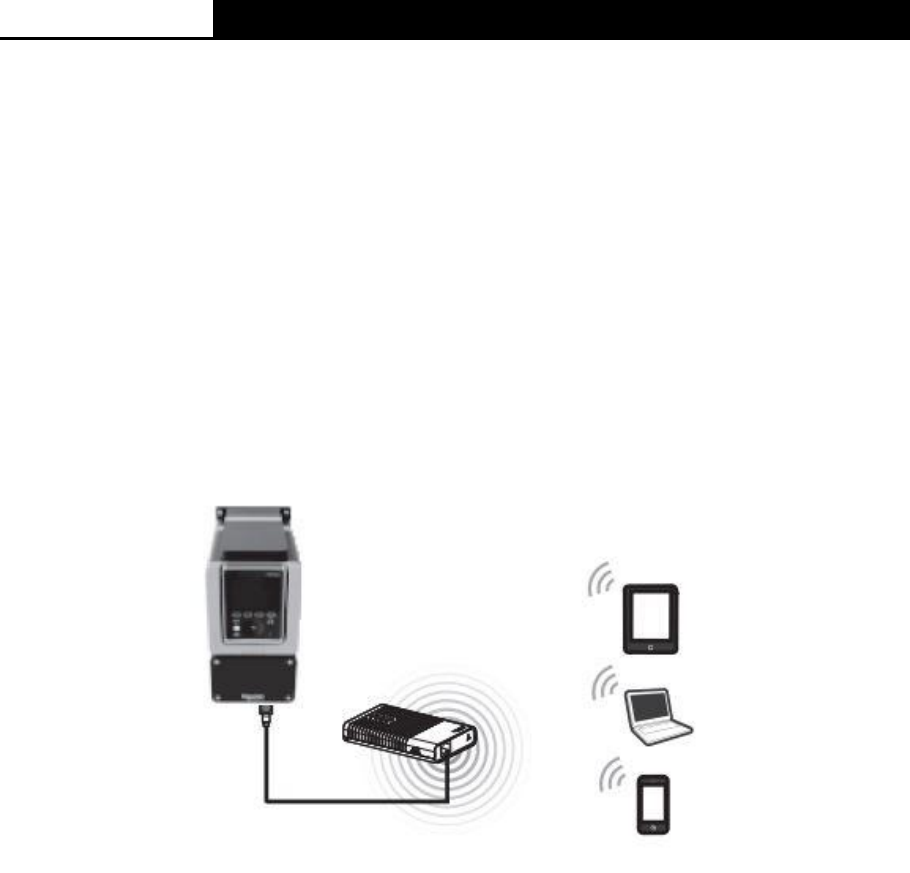
TCSEGWB13FA0
Portable Battery Powered WIFI Access Point
- 6 -
Chapter 3. Quick Installation Guide
This chapter will show you how to configure the basic functions of your TCSEGWB13FA0 Portable
Battery Powered WIFI Access Point.
3.1 Travel Router (AP) Mode
Access Point
In this mode, the TCSEGWB13FA0 is connected to a wired network and transforms the wired
Internet access into wireless so that multiple users can share the Internet.
3.2 PC configuration
Here we take Wireless Network Connection as an example. (You can also go to Local Area
Connection to configure the PC for wired network connection, and then configure the router.)
1. For Windows XP, please go to Start → Settings → Control Panel → Network and
Internet Connections → Network Connections; for Windows 7, please go to Start →
Settings → Control Panel → View network status and tasks → Manage network
connection. Right click Wireless Network Connection, and select Properties.
2. For Windows XP, double click Internet Protocol (TCP/IP) in the item list; for Windows 7,
double click Internet Protocol Version 4 (TCP/IPv4).
3. Select “Obtain an IP address automatically” and “Obtain DNS server address
automatically”. Click OK to finish the settings.
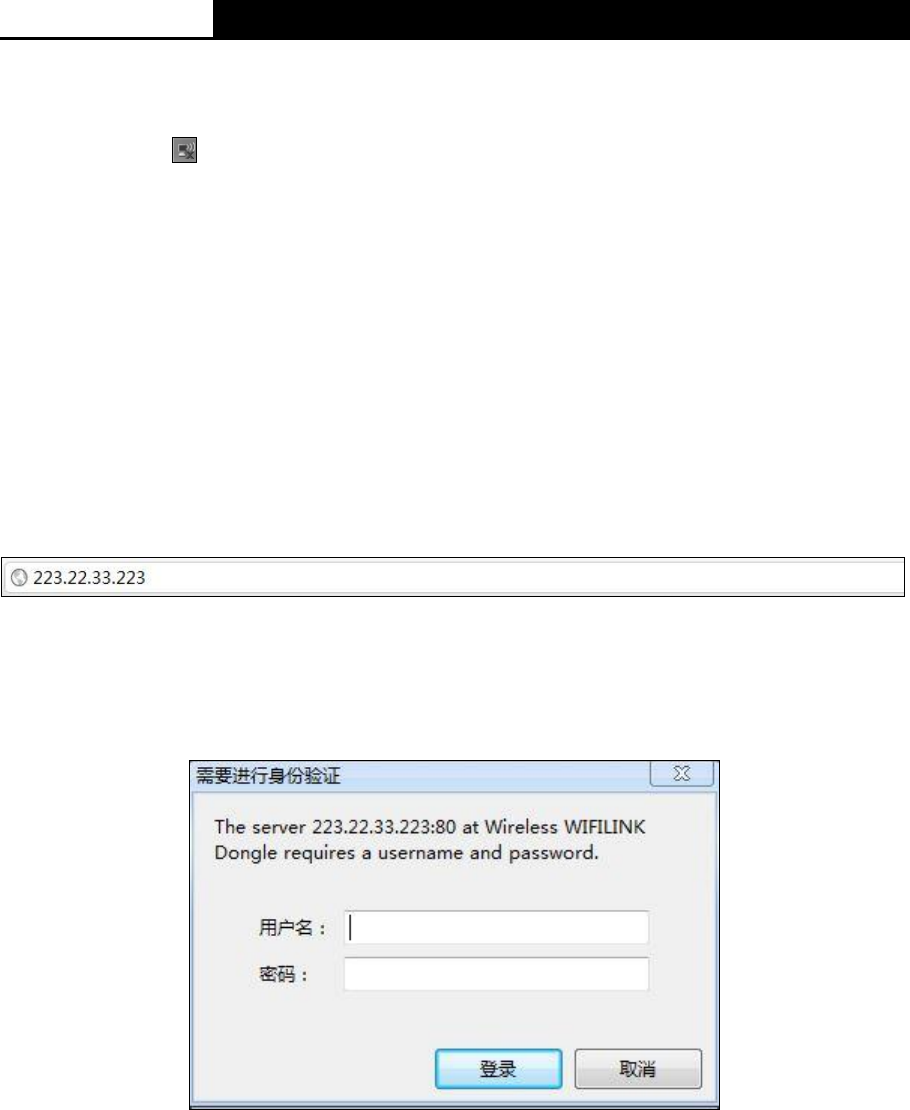
TCSEGWB13FA0
Portable Battery Powered WIFI Access Point
- 7 -
3.2.1 Connect to Network
1. Click the icon at the bottom of your desktop.
2. Click “Refresh network list”, and then select the network. Click Connect.
Note:
The default SSID of the network is SE_TCSEGW_xxxxxx. (The xxxxxx is the last six characters of
the router’s MAC address.)
3. When Connected appears, you’ve successfully connected to the wireless network.
3.2.2 Router Configuration
To access the configuration utility, open a web-browser and type the default address
http://223.22.33.223 in the address field of the browser.
Figure 3-1 Login the Router
After a moment, a login window will appear, similar to the Figure 3-2. Enter admin for the User
Name and Password, both in lower case letters. Then click the OK button or press the Enter key.
Figure 3-2 Login Windows
Note:
If the above screen does not pop-up, it means that your Web-browser has been set to a proxy. Go
to Tools menu>Internet Options>Connections>LAN Settings, in the screen that appears, cancel
the Using Proxy checkbox, and click OK to finish it.
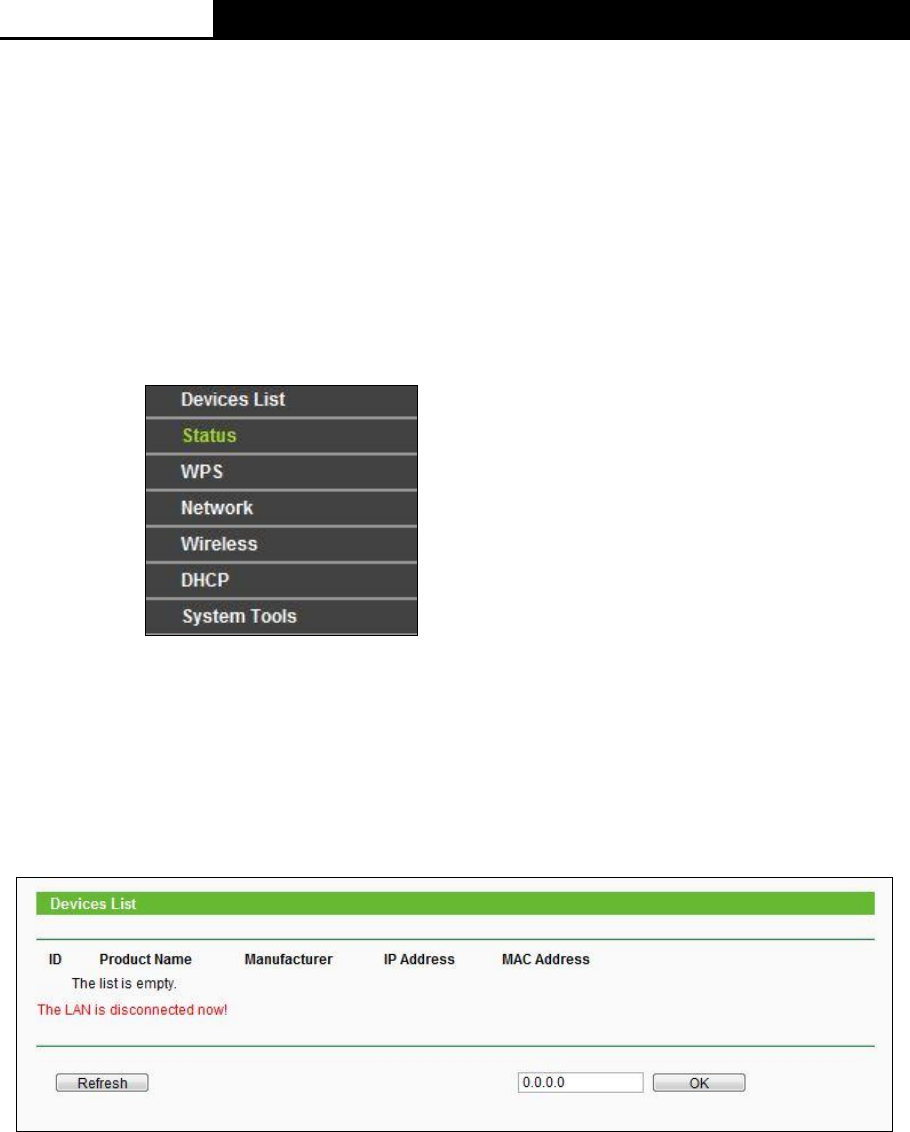
TCSEGWB13FA0
Portable Battery Powered WIFI Access Point
- 8 -
Chapter 4. Configuring the Router
This chapter will show each Web page's key functions and the configuration way.
4.1 Login
After your successful login, you will see the thirteen main menus on the left of the Web-based
utility. On the right, there are the corresponding explanations and instructions.
Figure 4-1 the main menu
The detailed explanations for each Web page’s key function are listed below.
4.2 Devices List
The Devices List page will display all the devices which link to the Router.
Figure 4-2 the Devices List
4.3 Status
The Status page provides the current status information about the Router. All information is
read-only.
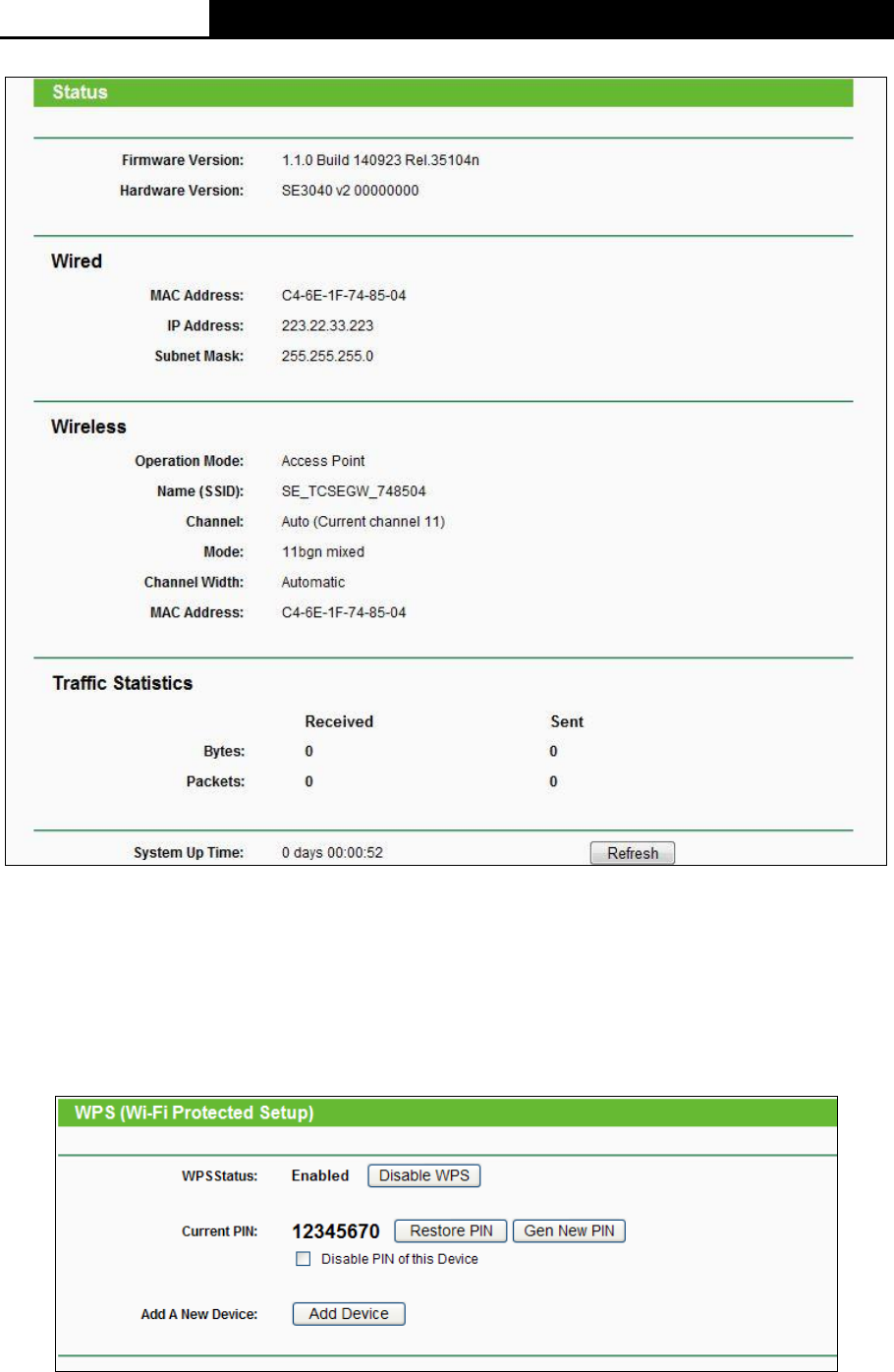
TCSEGWB13FA0
Portable Battery Powered WIFI Access Point
- 9 -
Figure 4-3 Router Status
4.4 WPS
This section will guide you to add a new wireless device to an existing network quickly by WPS
(Wifi Protected Setup) function.
a) Choose menu “WPS”, you will see the next screen (shown in Figure 4-4 ).
Figure 4-4 WPS
WPS Status - Enable or disable the WPS function here.
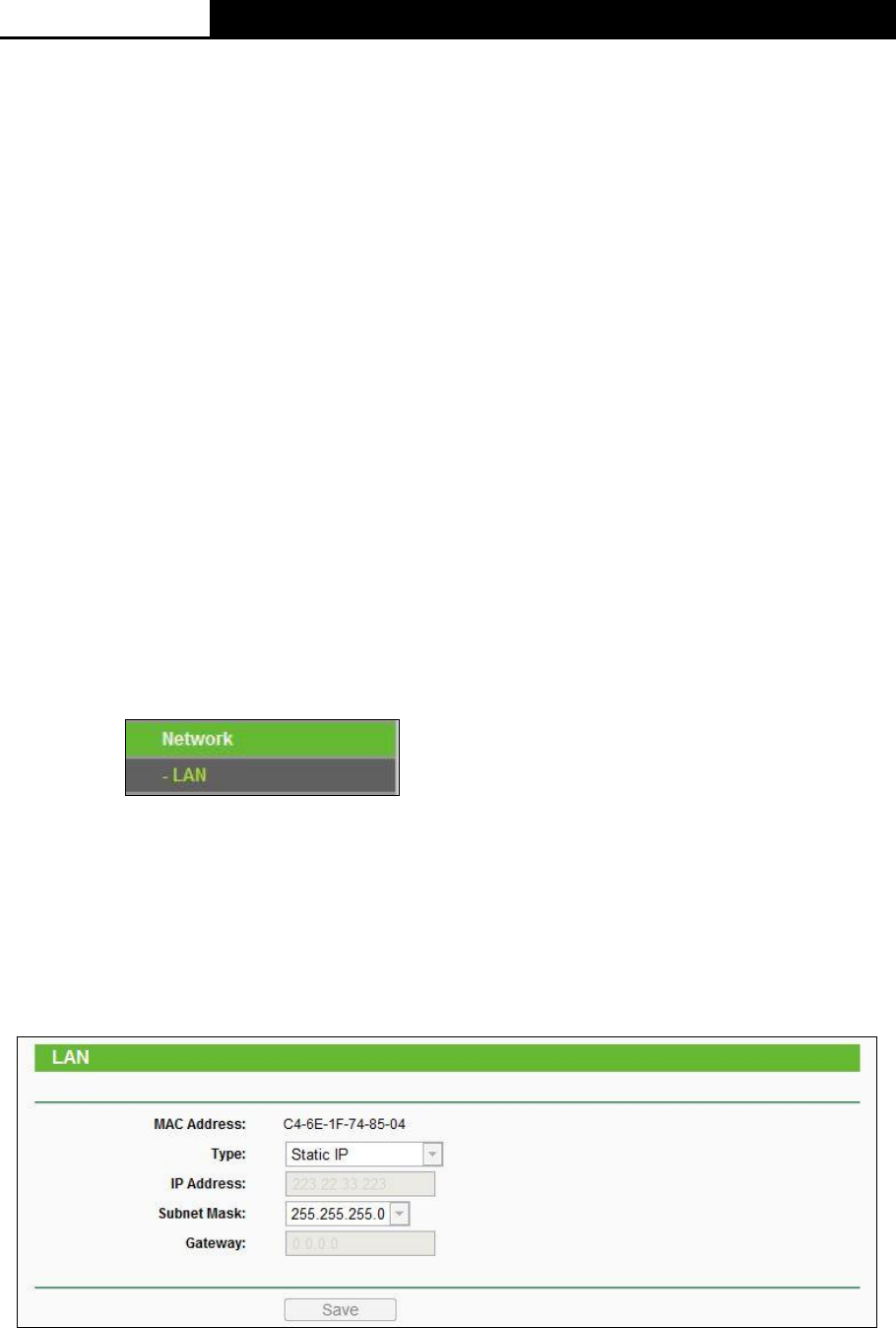
TCSEGWB13FA0
Portable Battery Powered WIFI Access Point
- 10 -
Current PIN - The current value of the Router's PIN is displayed here. The default PIN of the
Router can be found in the label or User Guide.
Restore PIN - Restore the PIN of the Router to its default.
Gen New PIN - Click this button, and then you can get a new random value for the Router's
PIN. You can ensure the network security by generating a new PIN.
Add device - You can add a new device to the existing network manually by clicking this
button.
b) To add a new device:
If the wireless adapter supports Wi-Fi Protected Setup (WPS), you can establish a wireless
connection between wireless adapter and Router using either Push Button Configuration (PBC)
method or PIN method.
Note:
To build a successful connection by WPS, you should also do the corresponding configuration of
the new device for WPS function meanwhile.
4.5 Network
Figure 4-5 the Network menu
There is one submenus under the Network menu (shown in Figure 4-5): LAN. Click it, and you will
be able to configure the corresponding function.
4.5.1 LAN
Choose menu “Network → LAN”, you can configure the IP parameters of the LAN on the screen
as below.
Figure 4-6 LAN
MAC Address - The physical address of the Router, as seen from the LAN. The value can't
be changed.
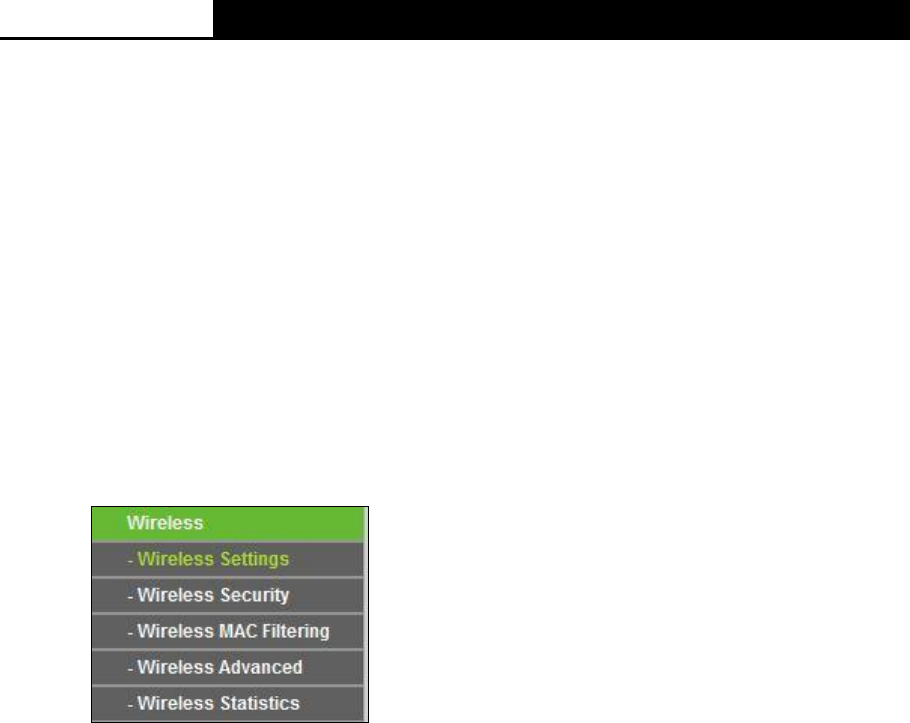
TCSEGWB13FA0
Portable Battery Powered WIFI Access Point
- 11 -
IP Address - Enter the IP address of your Router or reset it in dotted-decimal notation
(factory default: 223.22.33.223).
Subnet Mask - An address code that determines the size of the network. Normally use
255.255.255.0 as the subnet mask.
Note:
1. If you change the IP Address of LAN, you must use the new IP Address to log in the Router.
2. If the new LAN IP Address you set is not in the same subnet, the IP Address pool of the DHCP
server will change accordingly at the same time,while the Virtual Server and DMZ Host will
not take effect until they are re-configured.
4.6 Wireless
Figure 4-7 Wireless menu
There are five submenus under the Wireless menu (shown in Figure 4-7): Wireless Settings,
Wireless Security, Wireless MAC Filtering, Wireless Advanced and Wireless Statistics. Click
any of them, and you will be able to configure the corresponding function.
4.6.1 Wireless Settings
Choose menu “Wireless → Wireless Settings”, you can configure the basic settings for the
wireless network on this page.

TCSEGWB13FA0
Portable Battery Powered WIFI Access Point
- 12 -
Figure 4-8 Wireless Settings
SSID - Enter a value of up to 32 characters. The same name of SSID (Service Set
Identification) must be assigned to all wireless devices in your network. Considering your
wireless network security, the default SSID is set to be (XXXXXX indicates the last unique
six numbers of each Router’s MAC address). This value is case-sensitive. For example,
TEST is NOT the same as test.
Region - Select your region from the pull-down list. This field specifies the region where the
wireless function of the Router can be used. It may be illegal to use the wireless function of
the Router in a region other than one of those specified in this field. If your country or region
is not listed, please contact your local government agency for assistance.
When you select your local region from the pull-down list, click the Save button, then the
Note Dialog appears. Click OK.
Note Dialog
Note:
Limited by local law regulations, version for North America does not have region selection option.
Channel - This field determines which operating frequency will be used. The default channel
is set to Auto. so the AP will choose the best channel automatically. It is not necessary to
change the wireless channel unless you notice interference problems with another nearby
access point.
Mode - Select the desired mode. The default setting is 11bgn mixed.

TCSEGWB13FA0
Portable Battery Powered WIFI Access Point
- 13 -
11b only - Select if all of your wireless clients are 802.11b.
11g only - Select if all of your wireless clients are 802.11g.
11n only- Select only if all of your wireless clients are 802.11n.
11bg mixed - Select if you are using both 802.11b and 802.11g wireless clients.
11bgn mixed - Select if you are using a mix of 802.11b, 11g, and 11n wireless clients.
Select the desired wireless mode. When 802.11g mode is selected, only 802.11g wireless
stations can connect to the Router. When 802.11n mode is selected, only 802.11n wireless
stations can connect to the AP. It is strongly recommended that you set the Mode to
802.11b&g&n, and all of 802.11b, 802.11g, and 802.11n wireless stations can connect to
the Router.
Channel width - Select the channel width from the pull-down list. The default setting is
automatic, which can adjust the channel width for your clients automatically.
Note:
If 11b only, 11g only, or 11bg mixed is selected in the Mode field, the Channel Width
selecting field will turn grey and the value will become 20M, which is unable to be changed.
Enable Wireless Router Radio - The wireless radio of this Router can be enabled or
disabled to allow wireless stations access.
Enable SSID Broadcast - When wireless clients survey the local area for wireless networks
to associate with, they will detect the SSID broadcast by the Router. If you select the Enable
SSID Broadcast checkbox, the Wireless Router will broadcast its name (SSID) on the air.
4.6.2 Wireless Security
Choose menu “Wireless → Wireless Security”, you can configure the security settings of your
wireless network.
There are five wireless security modes supported by the Router: WEP (Wired Equivalent Privacy),
WPA (Wi-Fi Protected Access), WPA2 (Wi-Fi Protected Access 2), WPA-PSK (Pre-Shared Key),
WPA2-PSK (Pre-Shared Key).
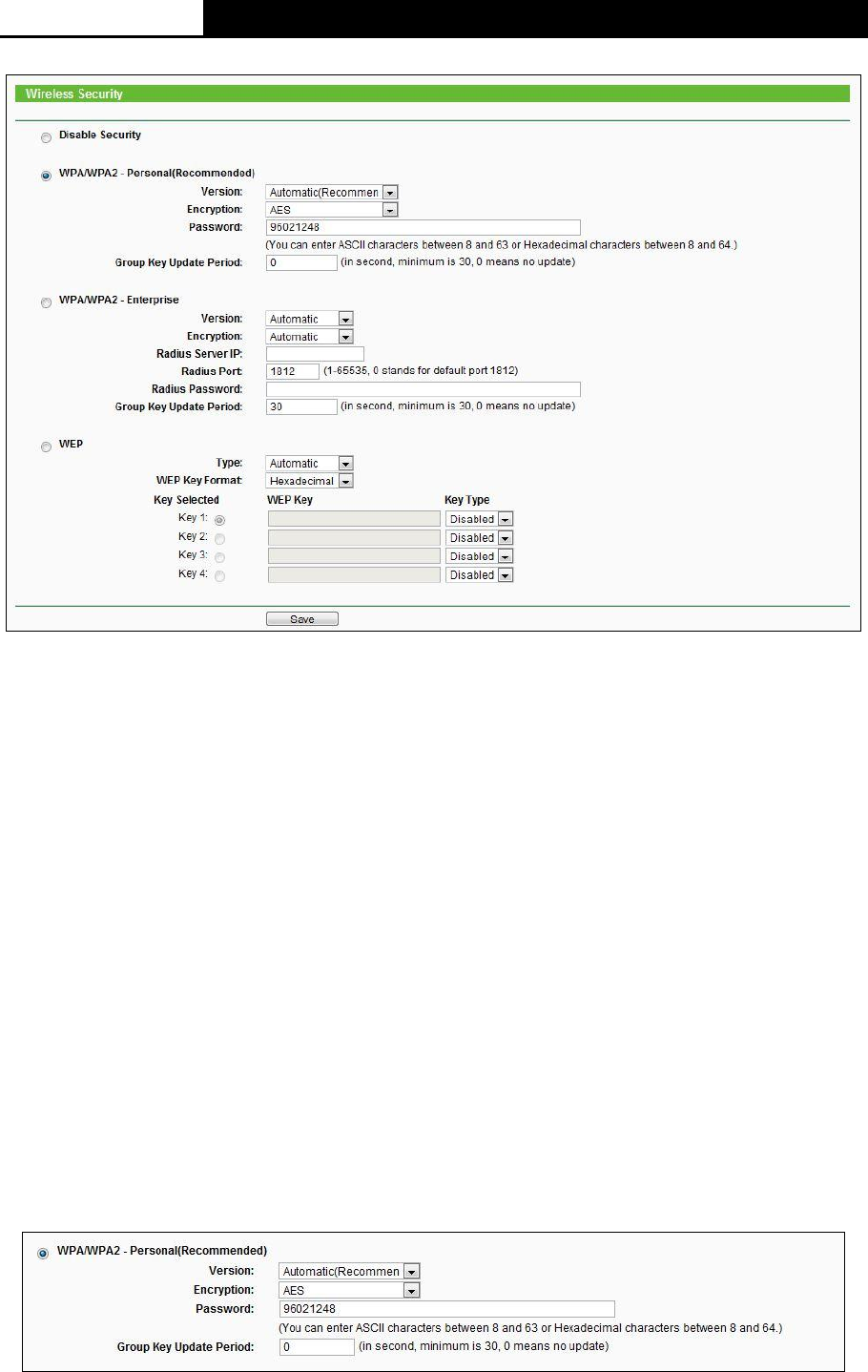
TCSEGWB13FA0
Portable Battery Powered WIFI Access Point
- 14 -
Figure 4-9 Wireless Security
Disable Security - If you do not want to use wireless security, select this check box, but it’s
strongly recommended to choose one of the following modes to enable security.
WPA/WPA2 – Personal (Recommended) - It’s the WPA/WPA2 authentication type based
on pre-shared passphrase.
Version - you can choose the version of the WPA-PSK security on the drop-down list. The
default setting is Automatic, which can select WPA-PSK (Pre-shared key of WPA) or
WPA2-PSK (Pre-shared key of WPA) automatically based on the wireless station's
capability and request.
Encryption - When WPA-PSK or WPA is set as the Authentication Type, you can select
either Automatic, or TKIP or AES as Encryption.
Note:
If you check the WPA/WPA2 – Personal (Recommended) radio button and choose TKIP
encryption, you will find a notice in red as shown in Figure 4-10.
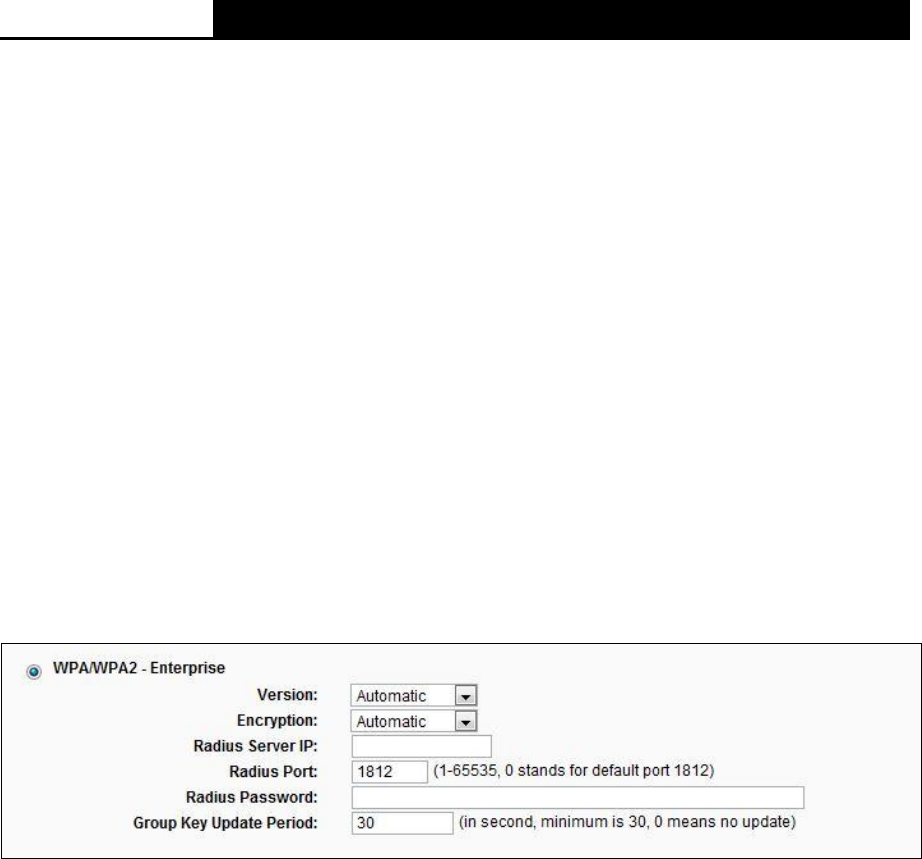
TCSEGWB13FA0
Portable Battery Powered WIFI Access Point
- 15 -
Figure 4-10
PSK Password - You can enter ASCII characters between 8 and 63 characters or 8 to 64
Hexadecimal characters.
Group Key Update Period - Specify the group key update interval in seconds. The value
should be 30 or above. Enter 0 to disable the update.
WPA /WPA2 - Enterprise - It’s based on Radius Server.
Version - you can choose the version of the WPA security on the pull-down list. The default
setting is Automatic, which can select WPA (Wi-Fi Protected Access) or WPA2 (WPA
version 2) automatically based on the wireless station's capability and request.
Encryption - You can select either Automatic, or TKIP or AES.
Note:
If you check the WPA/WPA2 - Enterprise radio button and choose TKIP encryption, you
will find a notice in red as shown in Figure 4-10.
Figure 4-11
Radius Server IP - Enter the IP address of the Radius Server.
Radius Port - Enter the port that radius service used.
Radius Password - Enter the password for the Radius Server.
Group Key Update Period - Specify the group key update interval in seconds. The value
should be 30 or above. Enter 0 to disable the update.
WEP - It is based on the IEEE 802.11 standard. If you select this check box, you will find a
notice in red as show in Figure 4-12.
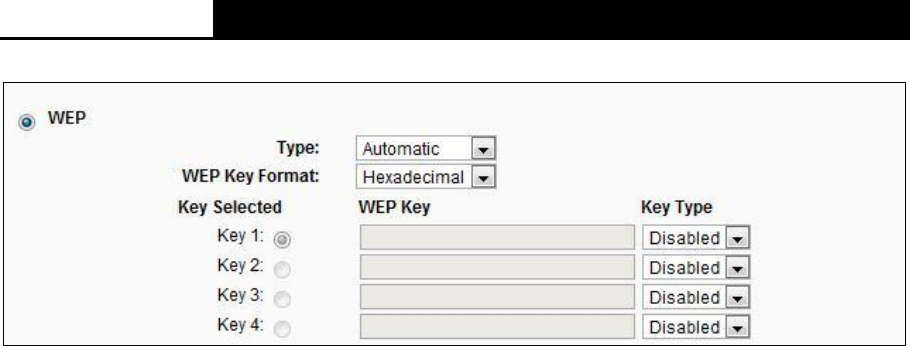
TCSEGWB13FA0
Portable Battery Powered WIFI Access Point
- 16 -
Figure 4-12
Type - you can choose the type for the WEP security on the pull-down list. The default
setting is Automatic, which can select Open System or Shared Key authentication type
automatically based on the wireless station's capability and request.
WEP Key Format - Hexadecimal and ASCII formats are provided. Hexadecimal format
stands for any combination of hexadecimal digits (0-9, a-f, A-F) in the specified length.
ASCII format stands for any combination of keyboard characters in the specified length.
WEP Key- Select which of the four keys will be used and enter the matching WEP key that
you create. Make sure these values are identical on all wireless stations in your network.
Key Type - You can select the WEP key length (64-bit, or 128-bit, or 152-bit.) for
encryption. "Disabled" means this WEP key entry is invalid.
64-bit - You can enter 10 hexadecimal digits (any combination of 0-9, a-f, A-F, zero key is
not promoted) or 5 ASCII characters.
128-bit - You can enter 26 hexadecimal digits (any combination of 0-9, a-f, A-F, zero key is
not promoted) or 13 ASCII characters.
152-bit - You can enter 32 hexadecimal digits (any combination of 0-9, a-f, A-F, zero key is
not promoted) or 16 ASCII characters.
Note:
If you do not set the key, the wireless security function is still disabled even if you have
selected Shared Key as Authentication Type.
Be sure to click the Save button to save your settings on this page.
4.6.3 Wireless MAC Filtering
Choose menu “Wireless → Wireless MAC Filtering”, you can control the wireless access by
configuring the Wireless MAC Address Filtering function, shown in Figure 4-13.
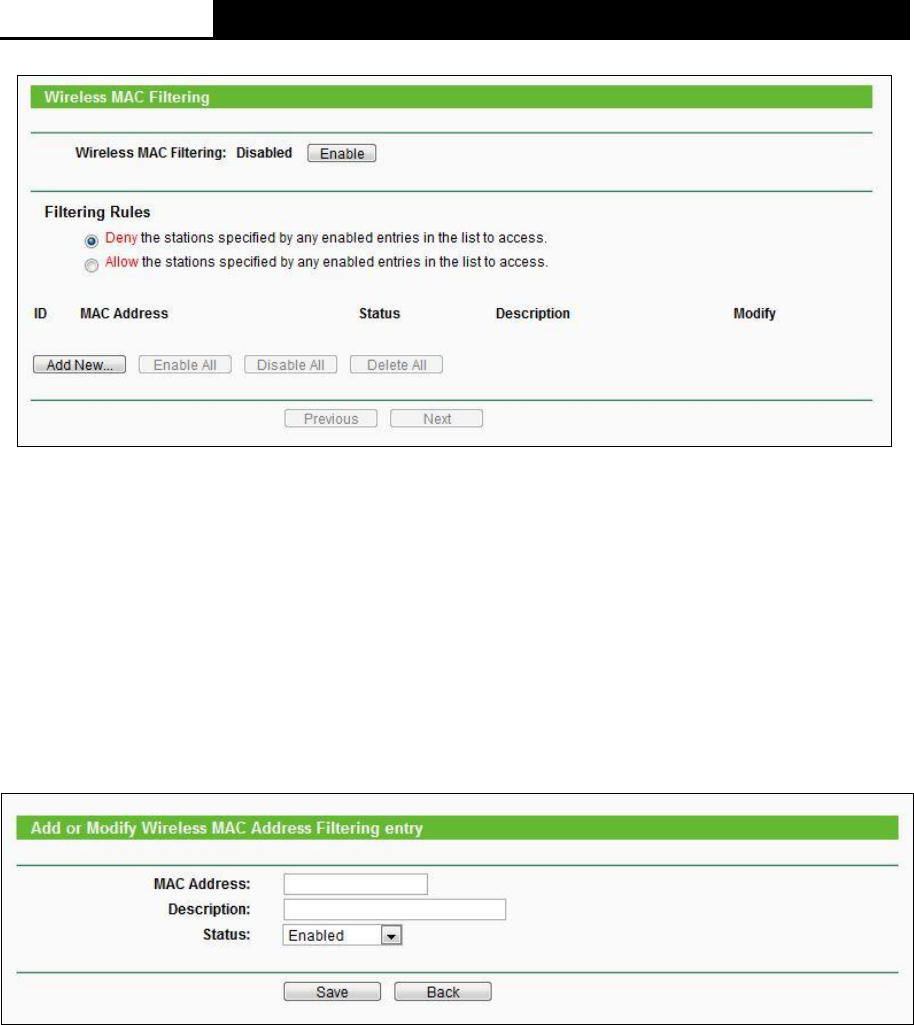
TCSEGWB13FA0
Portable Battery Powered WIFI Access Point
- 17 -
Figure 4-13 Wireless MAC address Filtering
To filter wireless users by MAC Address, click Enable. The default setting is Disabled.
MAC Address - The wireless station's MAC address that you want to filter.
Status - The status of this entry either Enabled or Disabled.
Description - A simple description of the wireless station.
To Add a Wireless MAC Address filtering entry, click the Add New… button. The "Add or Modify
Wireless MAC Address Filtering entry" page will appear, shown in Figure 4-14:
Figure 4-14 Add or Modify Wireless MAC Address Filtering entry
To add a MAC Address Filtering entry, follow these instructions:
1. Enter the appropriate MAC Address into the MAC Address field. The format of the MAC
Address is XX-XX-XX-XX-XX-XX (X is any hexadecimal digit). For example:
00-0A-EB-00-07-8A.
2. Enter a simple description of the wireless station in the Description field. For example:
Wireless station A.
3. Status - Select Enabled or Disabled for this entry on the Status pull-down list.
4. Click the Save button to save this entry.
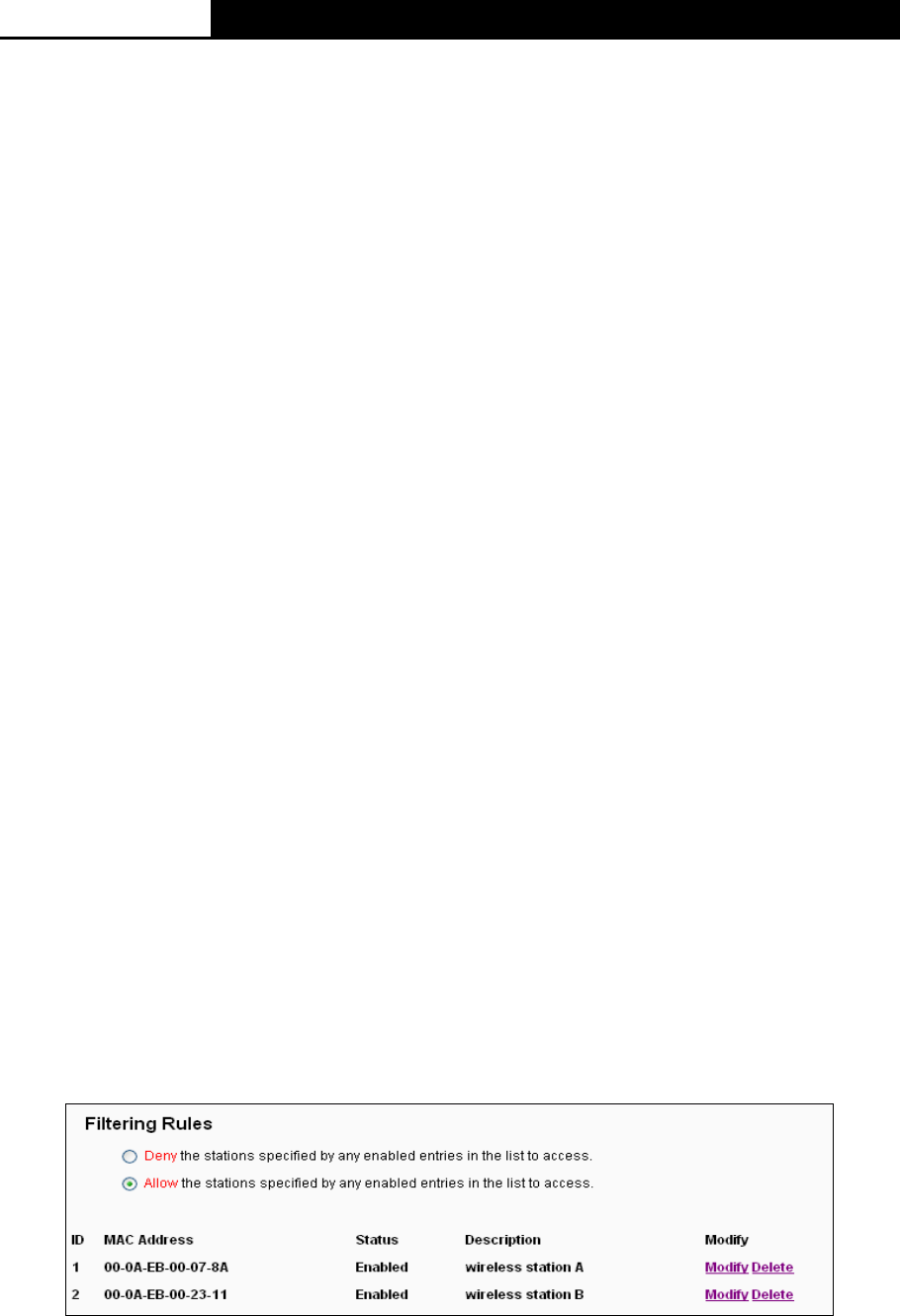
TCSEGWB13FA0
Portable Battery Powered WIFI Access Point
- 18 -
To modify or delete an existing entry:
1. Click the Modify in the entry you want to modify. If you want to delete the entry, click the
Delete.
2. Modify the information.
3. Click the Save button.
Click the Enable All button to make all entries enabled
Click the Disable All button to make all entries disabled.
Click the Delete All button to delete all entries
Click the Next button to go to the next page
Click the Previous button to return to the previous page.
For example: If you desire that the wireless station A with MAC address 00-0A-EB-00-07-8A and
the wireless station B with MAC address 00-0A-EB-00-23-11 are able to access the router, but all
the other wireless stations cannot access the router, you can configure the Wireless MAC
Filtering list by following these steps:
1. Click the Enable button to enable this function.
2. Select the radio button: Allow the stations specified by any enabled entries in the list to
access for Filtering Rules.
3. Delete all or disable all entries if there are any entries already.
4. Click the Add New... button and enter the MAC address 00-0A-EB-00-07-8A
/00-0A-EB-00-23-11 in the MAC Address field, then enter wireless station A/B in the
Description field, while select Enabled in the Status pull-down list. Finally, click the Save and
the Back button.
The filtering rules that configured should be similar to the following list:
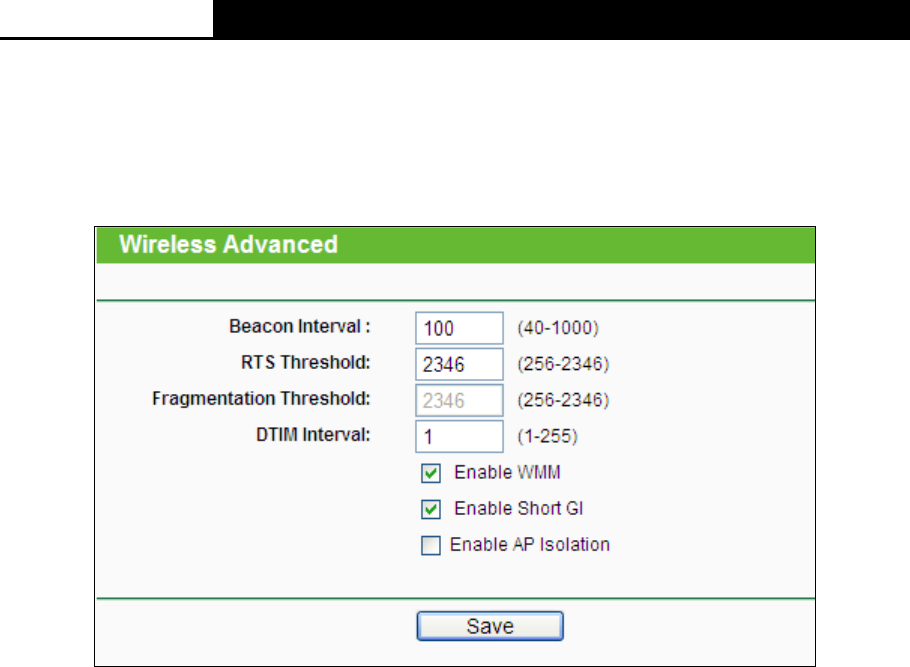
TCSEGWB13FA0
Portable Battery Powered WIFI Access Point
- 19 -
4.6.4 Wireless Advanced
Choose menu “Wireless→Wireless Advanced”, you can configure the advanced settings of your
wireless network.
Figure 4-15 Wireless Advanced
Beacon Interval - Enter a value between 40-1000 milliseconds for Beacon Interval here. The
beacons are the packets sent by the router to synchronize a wireless network. Beacon
Interval value determines the time interval of the beacons. The default value is 100.
RTS Threshold - Here you can specify the RTS (Request to Send) Threshold. If the packet is
larger than the specified RTS Threshold size, the router will send RTS frames to a particular
receiving station and negotiate the sending of a data frame. The default value is 2346.
Fragmentation Threshold - This value is the maximum size determining whether packets
will be fragmented. Setting the Fragmentation Threshold too low may result in poor network
performance since excessive packets. 2346 is the default setting and is recommended.
DTIM Interval - This value determines the interval of the Delivery Traffic Indication Message
(DTIM). A DTIM field is a countdown field informing clients of the next window for listening to
broadcast and multicast messages. When the router has buffered broadcast or multicast
messages for associated clients, it sends the next DTIM with a DTIM Interval value. You can
specify the value between 1-255 Beacon Intervals. The default value is 1, which indicates the
DTIM Interval is the same as Beacon Interval.
Enable WMM - WMM function can guarantee the packets with high- priority messages being
transmitted preferentially. It is strongly recommended enabled.
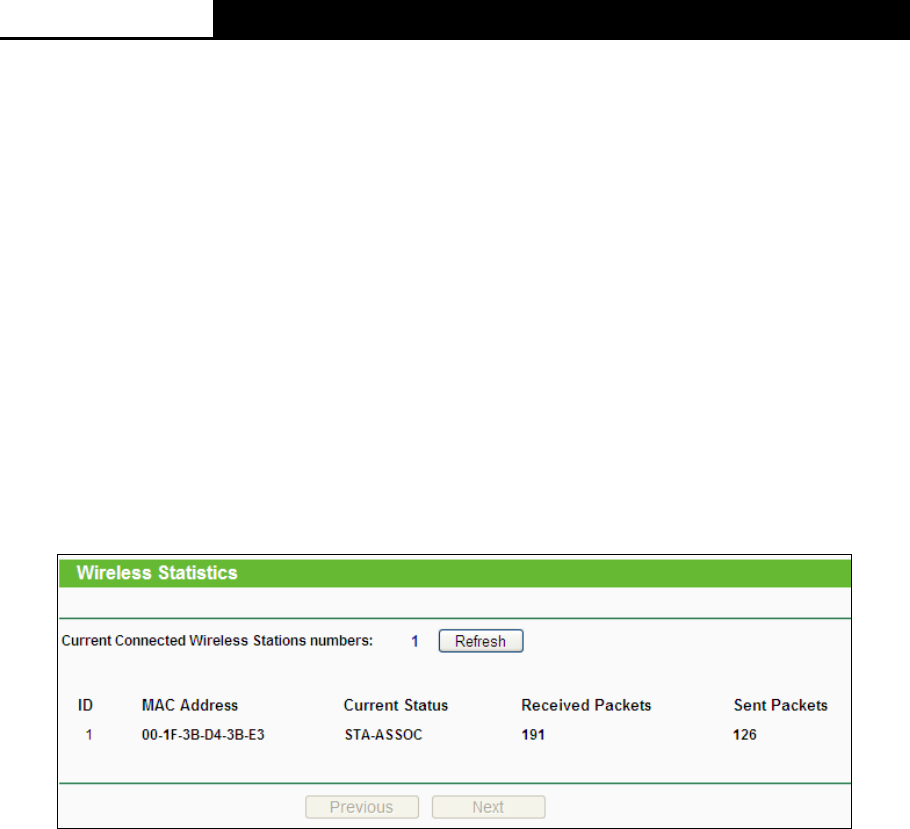
TCSEGWB13FA0
Portable Battery Powered WIFI Access Point
- 20 -
Enable Short GI - This function is recommended for it will increase the data capacity by
reducing the guard interval time.
Enabled AP Isolation - This function can isolate wireless stations on your network from each
other. Wireless devices will be able to communicate with the router but not with each other.
To use this function, check this box. AP Isolation is disabled by default.
Note:
If you are not familiar with the setting items on this page, it's strongly recommended to keep the
provided default values; otherwise it may result in lower wireless network performance.
4.6.5 Wireless Statistics
Choose menu “Wireless→Wireless Statistics”, you can see the MAC Address, Current Status,
Received Packets and Sent Packets for each connected wireless station.
Figure 4-16 The router attached wireless stations
MAC Address - The connected wireless station's MAC address.
Current Status - The connected wireless station's running status, one of STA-AUTH /
STA-ASSOC / STA-JOINED / WPA / WPA-PSK / WPA2 / WPA2-PSK / AP-UP / AP-DOWN /
Disconnected.
Received Packets - Packets received by the station.
Sent Packets - Packets sent by the station.
You cannot change any of the values on this page. To update this page and to show the current
connected wireless stations, click on the Refresh button.
If the numbers of connected wireless stations go beyond one page, click the Next button to go to
the next page and click the Previous button to return the previous page.
Note:
This page will be refreshed automatically every 5 seconds.
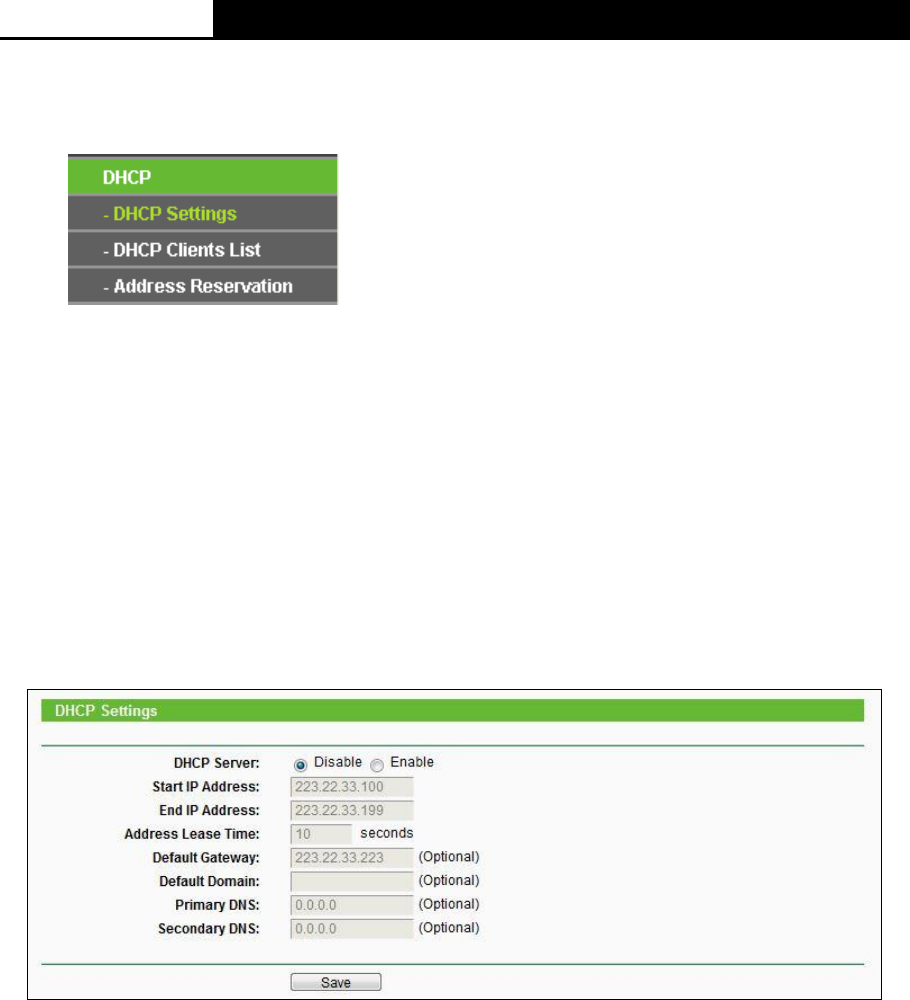
TCSEGWB13FA0
Portable Battery Powered WIFI Access Point
- 21 -
4.7 DHCP
Figure 4-17 The DHCP menu
There are three submenus under the DHCP menu (shown in Figure 4-16): DHCP Settings, DHCP
Clients List and Address Reservation. Click any of them, and you will be able to configure the
corresponding function.
4.7.1 DHCP Settings
Choose menu “DHCP→DHCP Settings”, you can configure the DHCP Server on the page (shown
in Figure 4-18).The router is set up by default as a DHCP (Dynamic Host Configuration Protocol)
server, which provides the TCP/IP configuration for all the PC(s) that are connected to the router
on the LAN.
Figure 4-18 DHCP Settings
DHCP Server - Enable or Disable the DHCP server. If you disable the Server, you must
have another DHCP server within your network or else you must configure the computer
manually.
Start IP Address - Specify an IP address for the DHCP Server to start with when assigning
IP addresses. 223.22.33.100 is the default start address.
End IP Address - Specify an IP address for the DHCP Server to end with when assigning IP
addresses. 223.22.33.199 is the default end address.
Address Lease Time - The Address Lease Time is the amount of time a network user will
be allowed connection to the router with their current dynamic IP Address. Enter the amount
of time in minutes and the user will be "leased" this dynamic IP Address. After the time is up,
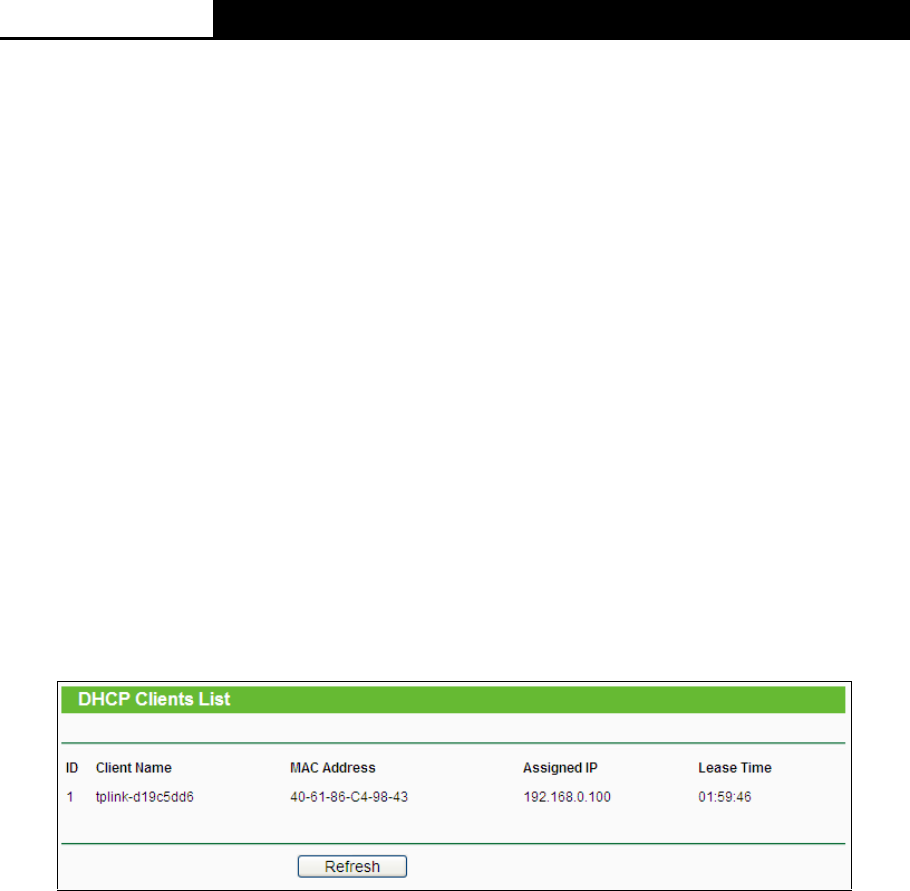
TCSEGWB13FA0
Portable Battery Powered WIFI Access Point
- 22 -
the user will be automatically assigned a new dynamic IP address. The range of the time is 1
~ 2880 minutes. The default value is 120 minutes.
Default Gateway - (Optional) Suggest to input the IP address of the LAN port of the router,
default value is 223.22.33.223.
Default Domain - (Optional) Input the domain name of your network.
Primary DNS - (Optional) Input the DNS IP address provided by your ISP. Or consult your
ISP.
Secondary DNS - (Optional) Input the IP address of another DNS server if your ISP
provides two DNS servers.
Note:
To use the DHCP server function of the router, you must configure all computers on the LAN as
"Obtain an IP address automatically" mode.
4.7.2 DHCP Clients List
Choose menu “DHCP→DHCP Clients List”, you can view the information about the clients
attached to the router in the next screen (shown in Figure 4-19).
Figure 4-19 DHCP Clients List
ID - The index of the DHCP Client.
Client Name - The name of the DHCP client.
MAC Address - The MAC address of the DHCP client.
Assigned IP - The IP address that the router has allocated to the DHCP client.
Lease Time - The time of the DHCP client leased. After the dynamic IP address has expired,
a new dynamic IP address will be automatically assigned to the user.
You cannot change any of the values on this page. To update this page and to show the current
attached devices, click the Refresh button.
4.7.3 Address Reservation
Choose menu “DHCP→Address Reservation”, you can view and add a reserved addresses for
clients via the next screen (shown in Figure 4-20).When you specify a reserved IP address for a
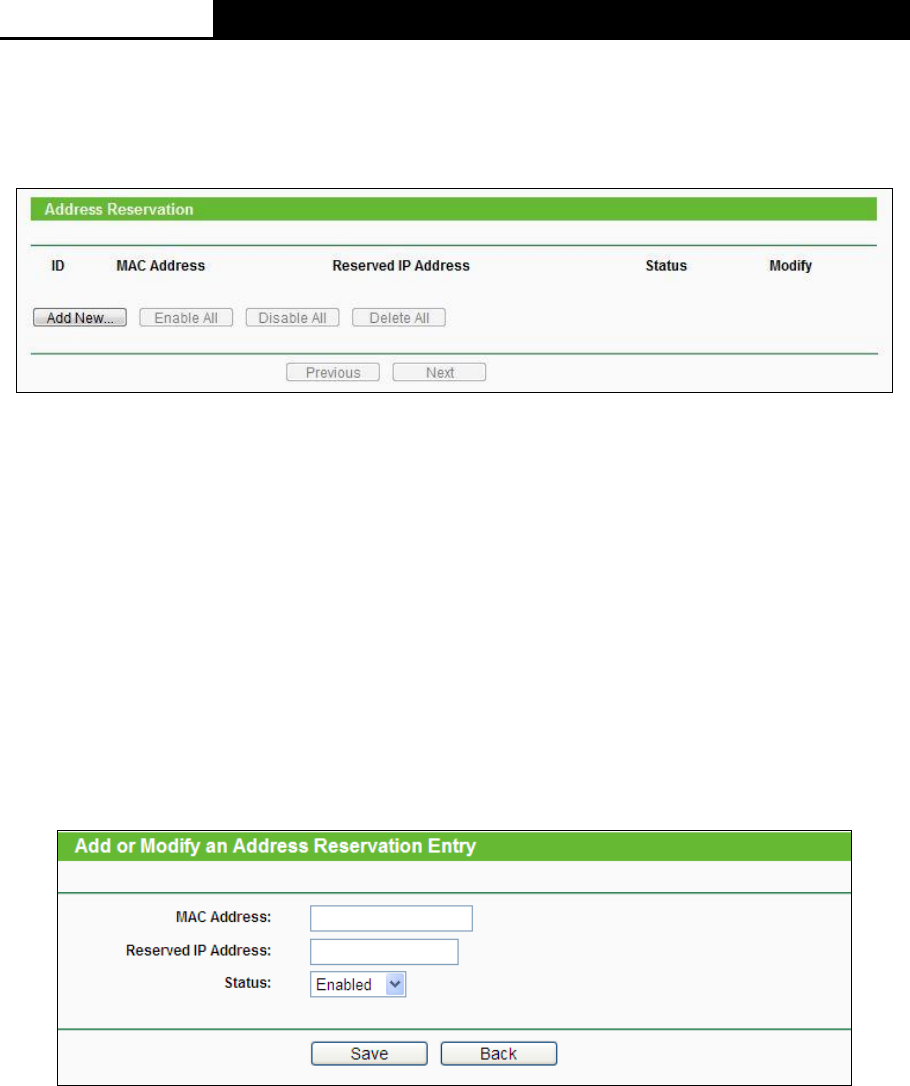
TCSEGWB13FA0
Portable Battery Powered WIFI Access Point
- 23 -
PC on the LAN, that PC will always receive the same IP address each time when it accesses the
DHCP server. Reserved IP addresses should be assigned to the servers that require permanent IP
settings.
Figure 4-20 Address Reservation
MAC Address - The MAC address of the PC for which you want to reserve IP address.
Reserved IP Address - The IP address of the router reserved.
Status - The status of this entry either Enabled or Disabled.
To Reserve IP addresses:
1. Click the Add New … button. (Pop-up Figure 4-20)
2. Enter the MAC address (in XX-XX-XX-XX-XX-XX format.) and IP address in dotted-decimal
notation of the computer you wish to add.
3. Click the Save button when finished.
Figure 4-21 Add or Modify an Address Reservation Entry
To modify or delete an existing entry:
1. Click the Modify in the entry you want to modify. If you want to delete the entry, click the
Delete.
2. Modify the information.
3. Click the Save button.
Click the Enable/ Disabled All button to make all entries enabled/disabled
Click the Delete All button to delete all entries
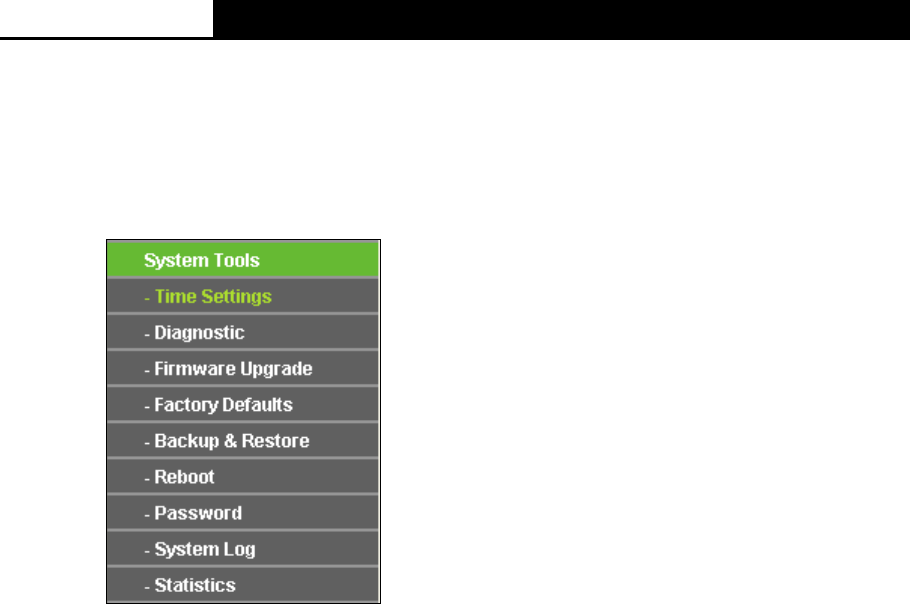
TCSEGWB13FA0
Portable Battery Powered WIFI Access Point
- 24 -
Click the Next button to go to the next page and click the Previous button to return the previous
page.
4.8 System Tools
Figure 4-22 The System Tools menu
Choose menu “System Tools”, and you can see the submenus under the main menu: Time
Settings, Diagnostic, Firmware Upgrade, Factory Defaults, Backup & Restore, Reboot,
Password, System Log and Statistics. Click any of them, and you will be able to configure the
corresponding function. The detailed explanations for each submenu are provided below.
4.8.1 Time Settings
Choose menu “System Tools→Time Settings”, and then you can configure the time on the
following screen.
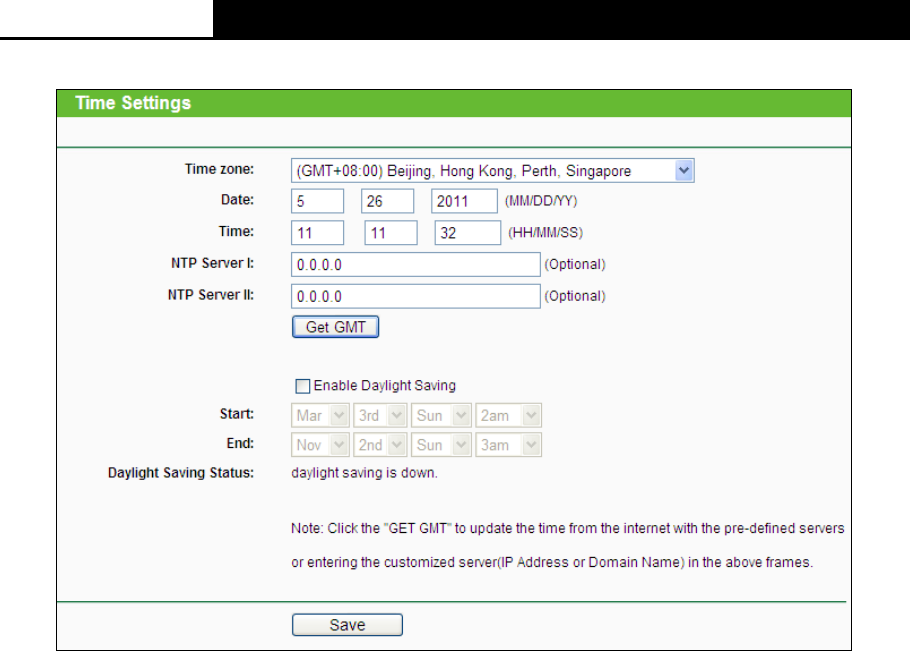
TCSEGWB13FA0
Portable Battery Powered WIFI Access Point
- 25 -
Figure 4-23 Time Settings
Time Zone - Select your local time zone from this pull down list.
Date - Enter your local date in MM/DD/YY into the right blanks.
Time - Enter your local time in HH/MM/SS into the right blanks.
NTP Server I / NTP Server II - Enter the address or domain of the NTP Server I or NTP
Server II, and then the router will get the time from the NTP Server preferentially. In addition,
the router built-in some common NTP Servers, so it can get time automatically once it
connects the Internet.
Enable Daylight Saving - Check the box to enable the Daylight Saving function.
Start - The time to start the Daylight Saving. Select the month in the first field, the week in the
second field, the day in the third field and the time in the last field.
End - The time to end the Daylight Saving. Select the month in the first field, the week in the
second field, the day in the third field and the time in the last field.
Daylight Saving Status - Displays the status whether the Daylight Saving is in use.
To set time manually:
1. Select your local time zone.
2. Enter the Date in Month/Day/Year format.
3. Enter the Time in Hour/Minute/Second format.
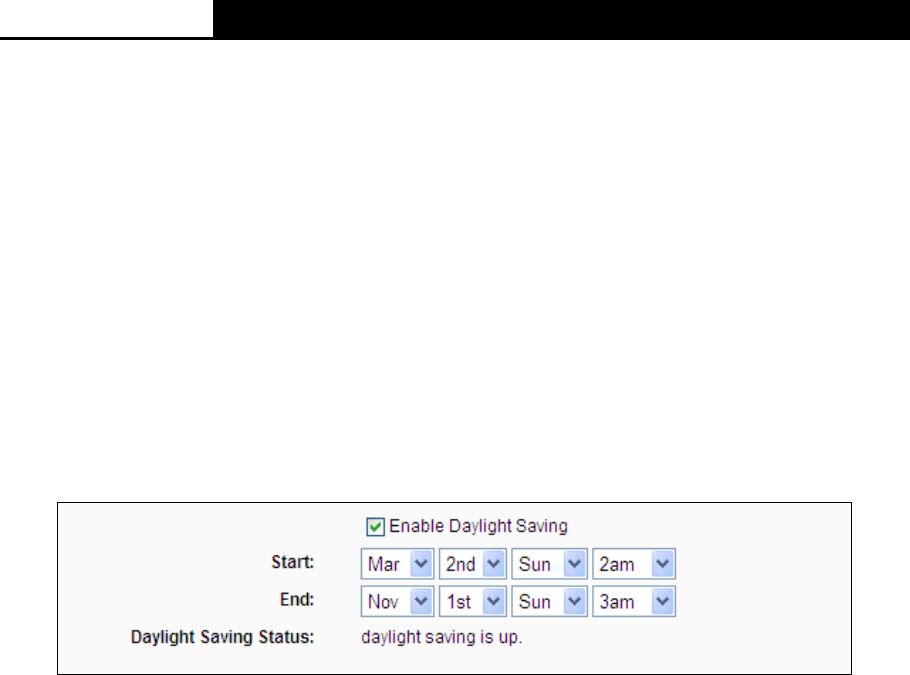
TCSEGWB13FA0
Portable Battery Powered WIFI Access Point
- 26 -
4. Click Save.
To set time automatically:
1. Select your local time zone.
2. Enter the address or domain of the NTP Server I or NTP Server II.
3. Click the Get GMT button to get system time from Internet if you have connected to the
Internet.
To set Daylight Saving:
1. Check the box to enable Daylight Saving.
2. Select the start time from the drop-down lists in the Start field.
3. Select the end time from the drop-down lists in the End field.
4. Click the Save button to save the settings.
Figure 4-24 Daylight Saving
Note:
1) The time will be lost if the router is turned off.
2) The router will automatically obtain GMT from the Internet if it is configured accordingly.
3) The Daylight Saving will take effect one minute after the configurations are completed.
4.8.2 Diagnostic
Choose menu “System Tools → Diagnostic”, you can transact Ping or Traceroute function to
check connectivity of your network in the following screen.
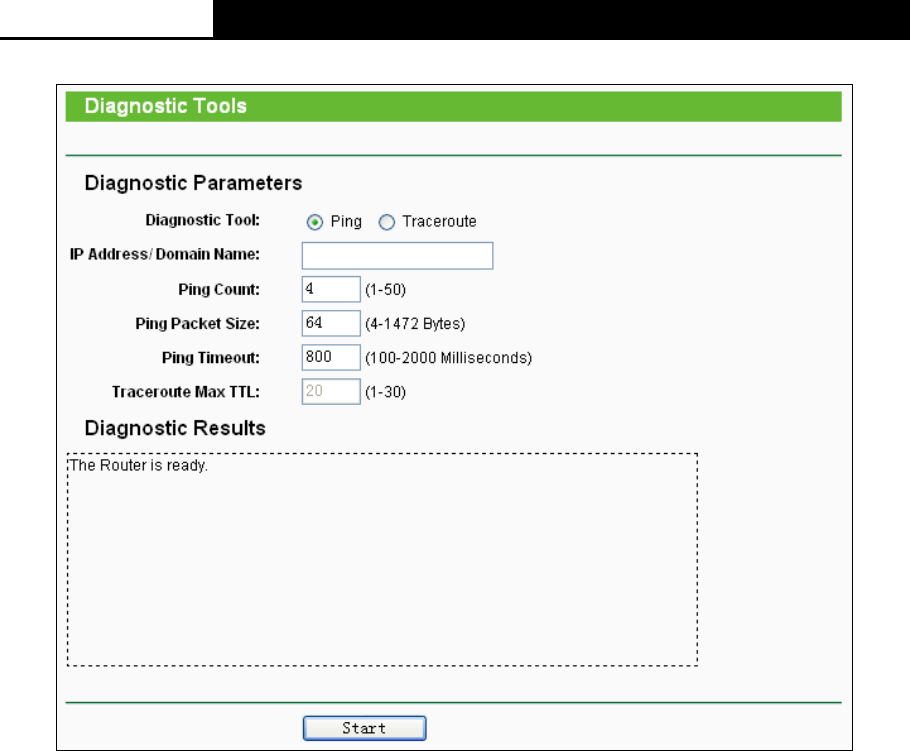
TCSEGWB13FA0
Portable Battery Powered WIFI Access Point
- 27 -
Figure 4-25 Diagnostic Tools
Diagnostic Tool - Check the radio button to select one diagnostic too.
Ping - This diagnostic tool troubleshoots connectivity, reachability, and name resolution to
a given host or gateway.
Traceroute - This diagnostic tool tests the performance of a connection.
Note:
You can use ping/traceroute to test both numeric IP address or domain name. If
pinging/tracerouting the IP address is successful, but pinging/tracerouting the domain name is
not, you might have a name resolution problem. In this case, ensure that the domain name
you are specifying can be resolved by using Domain Name System (DNS) queries.
IP Address/Domain Name - Type the destination IP address (such as 202.108.22.5) or Domain
name (such as http://www.tp-link.com)
Pings Count - The number of Ping packets for a Ping connection.
Ping Packet Size - The size of Ping packet.
Ping Timeout - Set the waiting time for the reply of each Ping packet. If there is no reply in
the specified time, the connection is overtime.
Traceroute Max TTL - The max number of hops for a Traceroute connection.
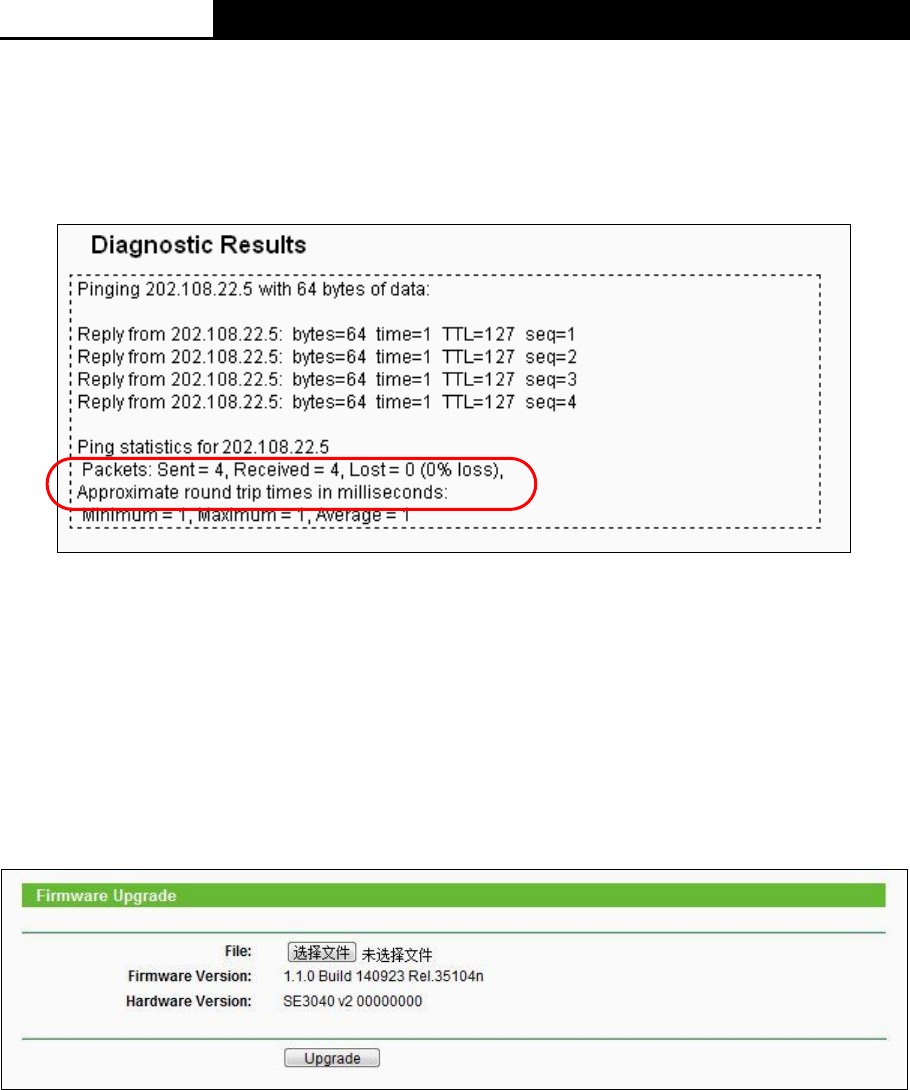
TCSEGWB13FA0
Portable Battery Powered WIFI Access Point
- 28 -
Click Start to check the connectivity of the Internet.
The Diagnostic Results page displays the result of diagnosis.
If the result is similar to the following screen, the connectivity of the Internet is fine.
Figure 4-26 Diagnostic Results
Note:
Only one user can use this tool at one time. Options “Number of Pings”, “Ping Size” and “Ping
Timeout” are used for Ping function. Option “Tracert Hops” are used for Tracert function.
4.8.3 Firmware Upgrade
Choose menu “System Tools → Firmware Upgrade”, you can update the latest version of
firmware for the router on the following screen.
Figure 4-27 Firmware Upgrade
Firmware Version - This displays the current firmware version.
Hardware Version - This displays the current hardware version. The hardware version of the
upgrade file must accord with the router’s current hardware version.
To upgrade the router's firmware, follow these instructions below:
1. Download a more recent firmware upgrade file from the TP-LINK website
(http://www.tp-link.com).
2. Type the path and file name of the update file into the File field. Or click the Browse button to
locate the update file.
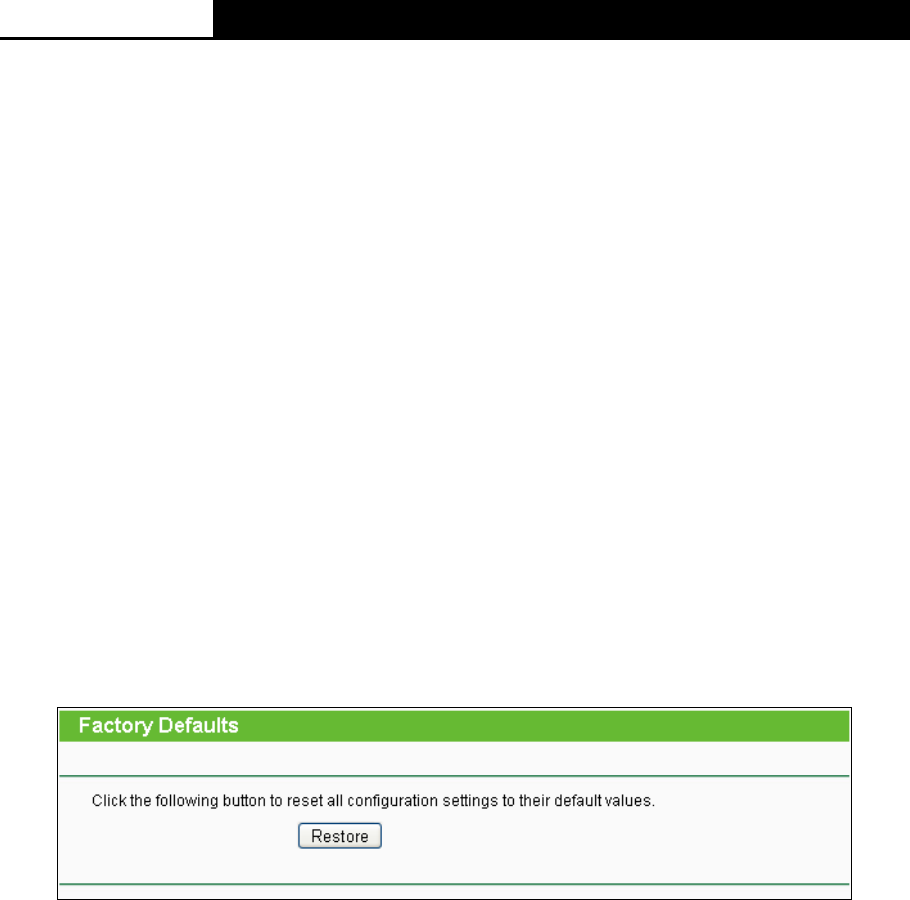
TCSEGWB13FA0
Portable Battery Powered WIFI Access Point
- 29 -
3. Click the Upgrade button.
Note:
1) Each rule can only be used by one host on the LAN at a time. The trigger connection of other
hosts on the LAN will be refused. New firmware versions are posted at http://www.tp-link.com
and can be downloaded for free. There is no need to upgrade the firmware unless the new
firmware has a new feature you want to use. However, when experiencing problems caused
by the router rather than the configuration, you can try to upgrade the firmware.
2) When you upgrade the router's firmware, you may lose its current configurations, so before
upgrading the firmware please write down some of your customized settings to avoid losing
important settings.
3) Do not turn off the router or press the Reset button while the firmware is being upgraded,
otherwise, the router may be damaged.
4) The router will reboot after the upgrading has been finished.
4.8.4 Factory Defaults
Choose menu “System Tools → Factory Defaults”, and you can restore the configurations of
the router to factory defaults on the following screen.
Figure 4-28 Restore Factory Default
Click the Restore button to reset all configuration settings to their default values.
The default User Name: admin
The default Password: admin
The default IP Address: 223.22.33.223
The default Subnet Mask: 255.255.255.0
Note:
Any settings you have saved will be lost when the default settings are restored.
4.8.5 Backup & Restore
Choose menu “System Tools → Backup & Restore”, you can save the current configuration of
the router as a backup file and restore the configuration via a backup file as shown in Figure 5-86.
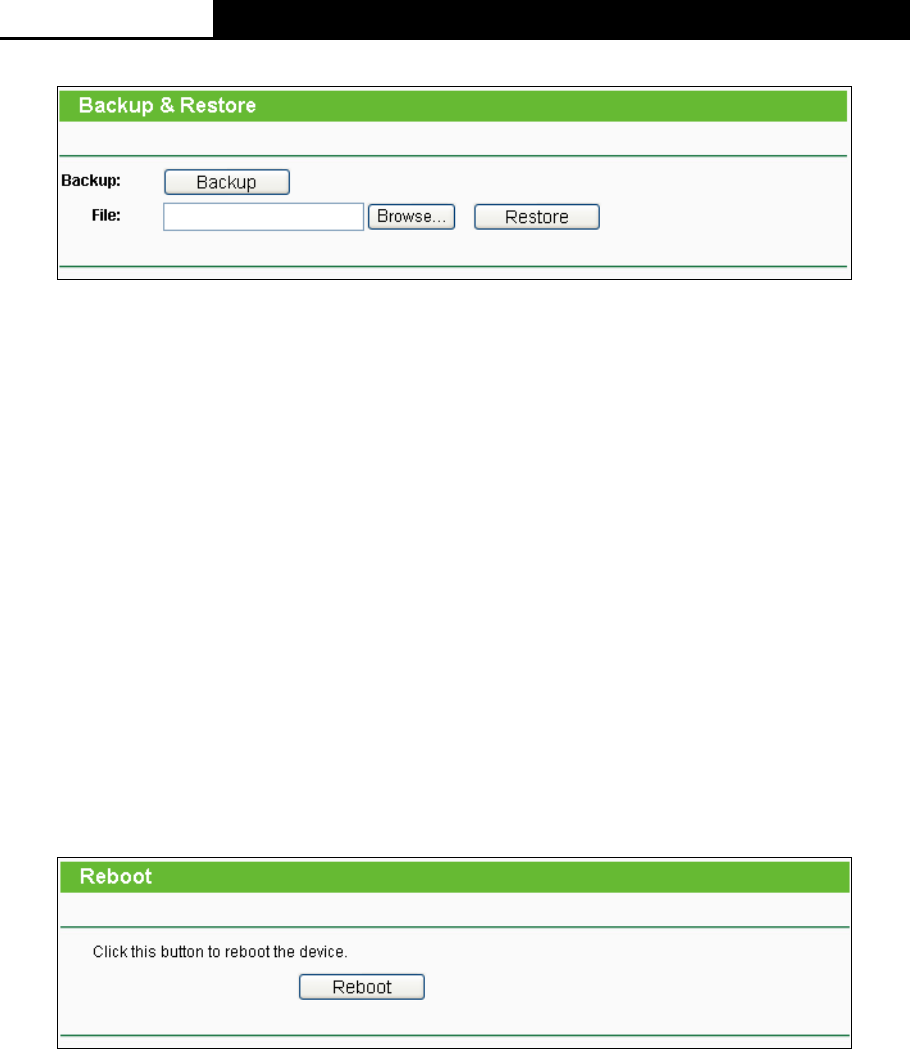
TCSEGWB13FA0
Portable Battery Powered WIFI Access Point
- 30 -
Figure 4-29 Backup & Restore Configuration
Click the Backup button to save all configuration settings as a backup file in your local
computer.
To upgrade the router's configuration, follow these instructions.
Click the Browse… button to locate the update file for the router, or enter the exact path
to the Setting file in the text box.
Click the Restore button.
Note:
The current configuration will be covered by the uploading configuration file. The upgrade process
lasts for 20 seconds and the router will restart automatically. Keep the router on during the
upgrading process to prevent any damage.
4.8.6 Reboot
Choose menu “System Tools → Reboot”, you can click the Reboot button to reboot the router.
Figure 4-30 Reboot the router
Some settings of the router will take effect only after rebooting, which include
Change the LAN IP Address (system will reboot automatically).
Change the DHCP Settings.
Change the Wireless configurations.
Change the Web Management Port.
Upgrade the firmware of the router (system will reboot automatically).
Restore the router's settings to factory defaults (system will reboot automatically).
Update the configuration with the file (system will reboot automatically).
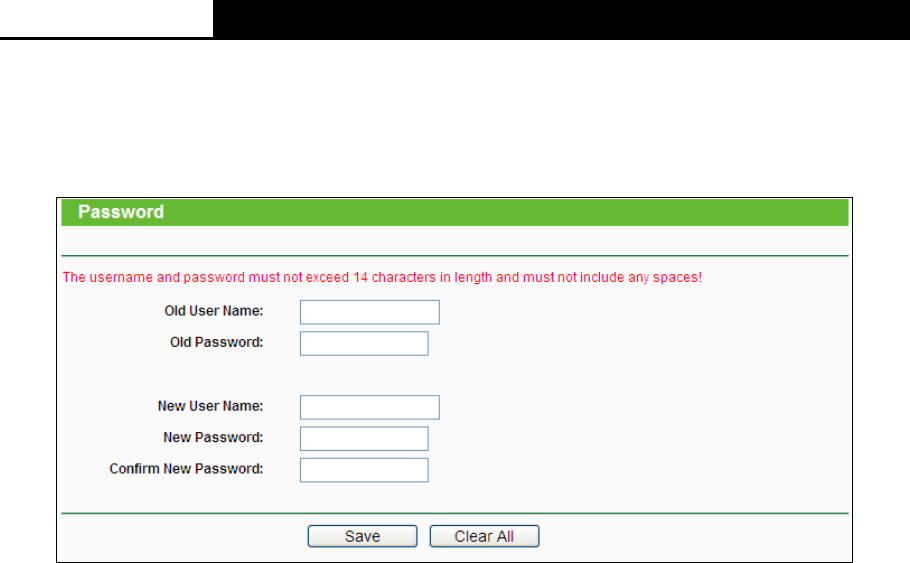
TCSEGWB13FA0
Portable Battery Powered WIFI Access Point
- 31 -
4.8.7 Password
Choose menu “System Tools → Password”, you can change the factory default user name and
password of the router in the next screen as shown in Figure 4-31.
Figure 4-31 Password
It is strongly recommended that you should change the factory default user name and password of
the router, because all users who try to access the router's Web-based utility or Quick Setup will
be prompted for the router's default user name and password.
Note:
The new user name and password must not exceed 14 characters in length and not include any
spaces. Enter the new Password twice to confirm.
Click the Save button when finished.
Click the Clear All button to clear all.
4.8.8 System Log
Choose menu “System Tools → System Log”, you can view the logs of the router.
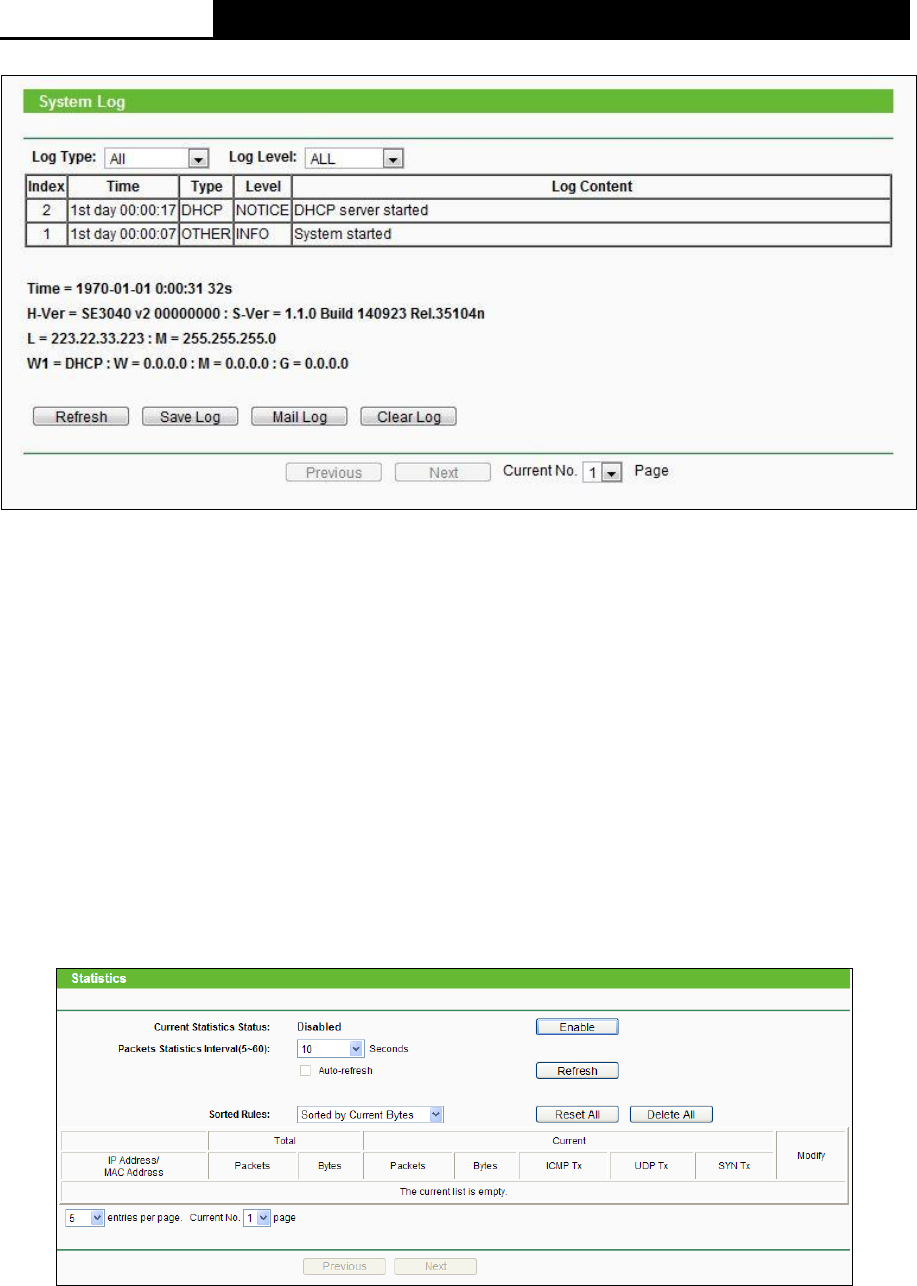
TCSEGWB13FA0
Portable Battery Powered WIFI Access Point
- 32 -
Figure 4-32 System Log
Log Type - By selecting the log type, only logs of this type will be shown.
Log Level - By selecting the log level, only logs of this level will be shown.
Refresh - Refresh the page to show the latest log list.
Save Log - Click to save all the logs in a txt file.
Clear Log - All the logs will be deleted from the router permanently, not just from the page.
Click the Next button to go to the next page, or click the Previous button return to the previous
page.
4.8.9 Statistics
Choose menu “System Tools → Statistics”, you can view the statistics of the router, including
total traffic and current traffic of the last Packets Statistic Interval.
Figure 4-33 Statistics
Current Statistics Status - Enable or Disable. The default value is disabled. To enable, click
the Enable button. If disabled, the function of DoS protection in Security settings will disabled.
Packets Statistics Interval (5-60) - The default value is 10. Select a value between 5 and

TCSEGWB13FA0
Portable Battery Powered WIFI Access Point
- 33 -
60 seconds in the pull-down list. The Packets Statistic interval indicates the time section of the
packets statistic.
Sorted Rules - Choose how displayed statistics are sorted.
Select the Auto-refresh checkbox to refresh automatically.
Click the Refresh button to refresh immediately.
Click Reset All to reset the values of all the entries to zero.
Click Delete All to delete all entries in the table.
Statistics Table:
IP/MAC Address
The IP and MAC address are displayed with related statistics.
Total
Packets
The total number of packets received and transmitted by the
router.
Bytes
The total number of bytes received and transmitted by the router.
Current
Packets
The total number of packets received and transmitted in the last
Packets Statistic interval seconds.
Bytes
The total number of bytes received and transmitted in the last
Packets Statistic interval seconds.
ICMP
Tx
The number of the ICMP packets transmitted to WAN per second
at the specified Packets Statistics interval. It is shown like
“current transmitting rate / Max transmitting rate”.
UDP Tx
The number of UDP packets transmitted to the WAN per second
at the specified Packets Statistics interval. It is shown like
“current transmitting rate / Max transmitting rate”.
TCP
SYN Tx
The number of TCP SYN packets transmitted to the WAN per
second at the specified Packets Statistics interval. It is shown like
“current transmitting rate / Max transmitting rate”.
Modify
Reset
Reset the value of he entry to zero.
Delete
Delete the existing entry in the table.
There would be 5 entries on each page. Click Previous to return to the previous page and Next to
the next page.
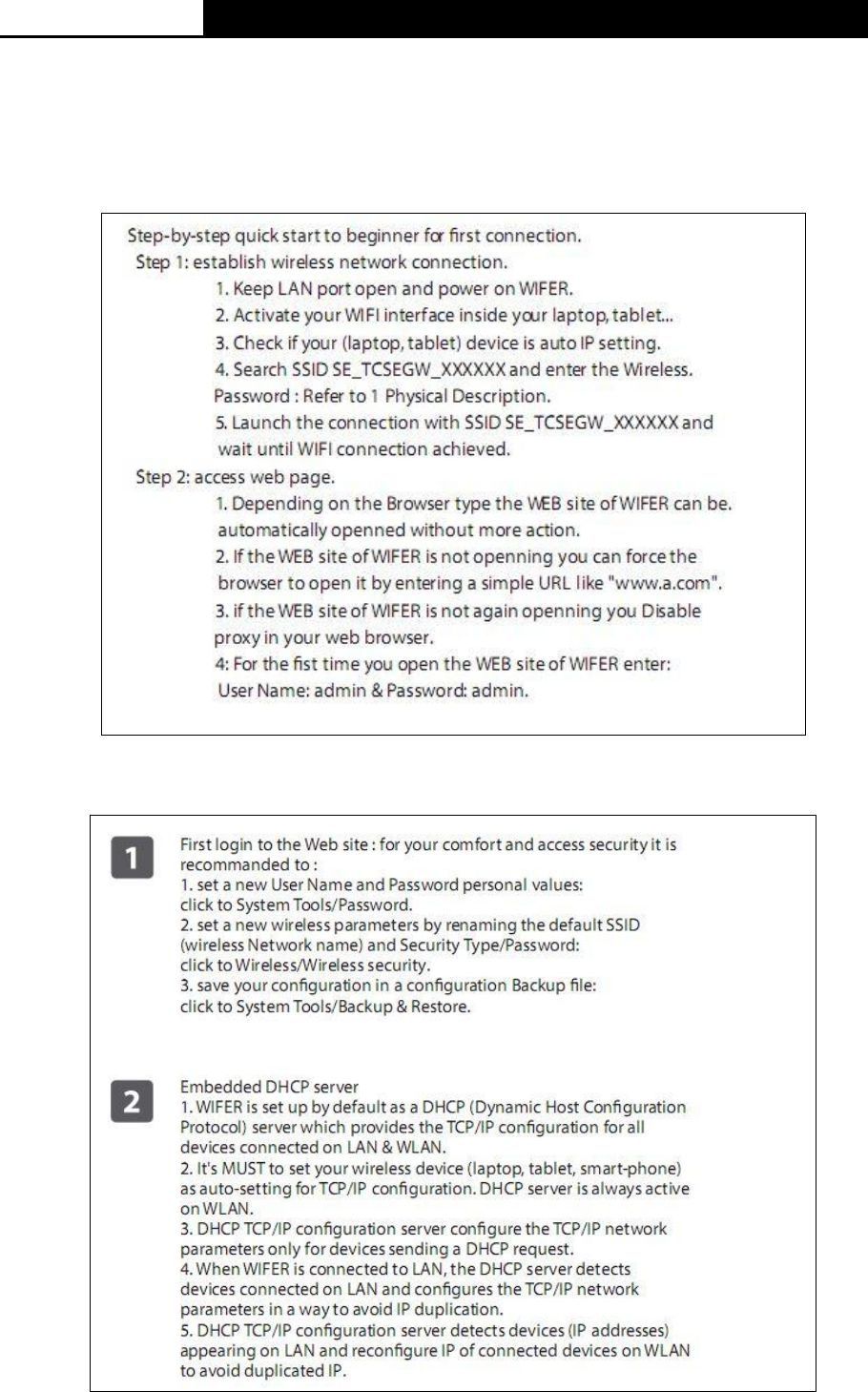
TCSEGWB13FA0
Portable Battery Powered WIFI Access Point
- 34 -
Appendix A: FAQ
1. How to quick start to beginner for first connection?
2. Router Configuration
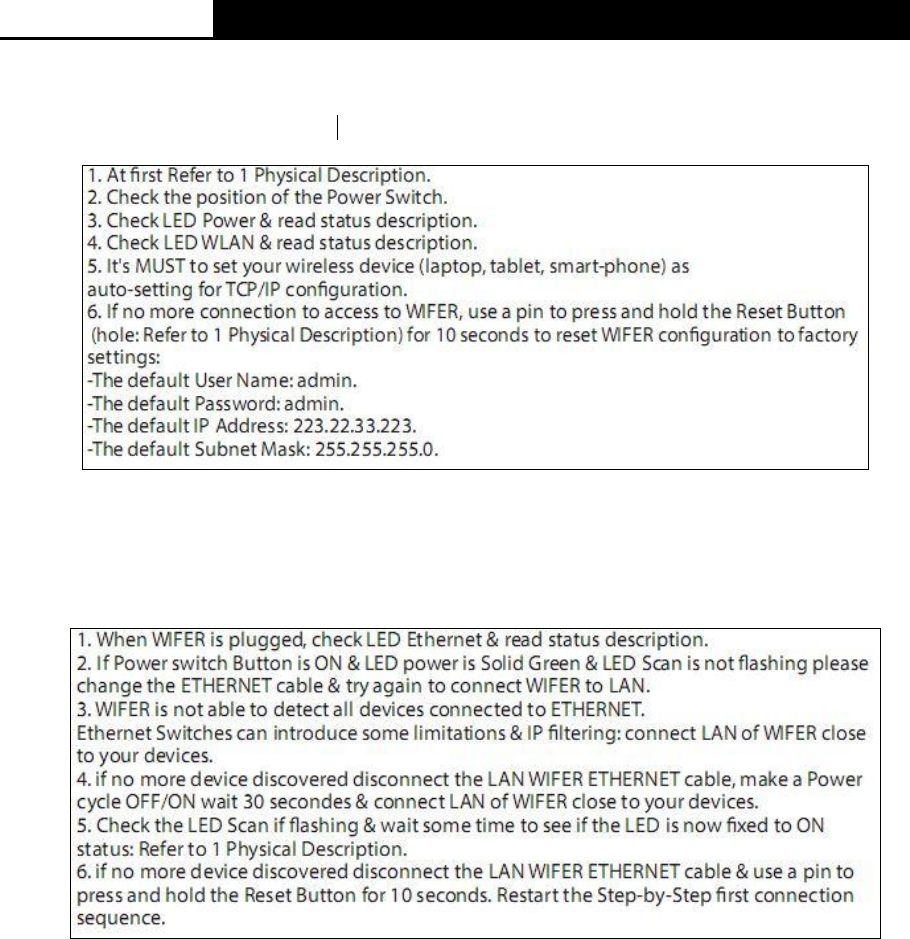
TCSEGWB13FA0
Portable Battery Powered WIFI Access Point
- 35 -
3. What should I do when I am not able to connect my labtop, tablet, smart-phone to
TCSEGWB13FA0 using WIFI?
4. What should I do when I am not able to see presence of devices connected to LAN in
the WEBpage Device List?

TCSEGWB13FA0
Portable Battery Powered WIFI Access Point
- 36 -
Appendix B: Specifications
General
Standards
IEEE 802.11n、 IEEE 802.11g、IEEE 802.11b、IEEE 802.3、IEEE
802.3u、IEEE 802.3x、IEEE 802.1X
Protocols
TCP/IP、DHCP、NAT
Ports
One 10/100M Auto-Negotiation WAN/LAN RJ45 port (Auto
MDI/MDIX)
Cabling Type
10BASE-T: UTP category 3, 4, 5 cable (maximum 100m)
100BASE-TX: UTP category 5, 5e cable (maximum 100m)
LEDs
PWR, Internet, WLAN, Ethernet
Safety & Emissions
FCC, CE
Wireless
Frequency Band
2.4~2.4835GHz
Radio Data Rate
11n:up to 150Mbps(Automatic)
11g:54/48/36/24/18/12/9/6M(Automatic)
11b:11/5.5/2/1M(Automatic)
Frequency Expansion
DSSS (Direct Sequence Spread Spectrum)
Modulation
11n:BPSK,QPSK,16-QAM,64-QAM
11g:BPSK,QPSK,16-QAM,64-QAM
11b:CCK,DQPSK,DBPSK
Security
WEP/WPA/WPA2/WPA2-PSK/WPA-PSK
Antenna Gain
0dBi
Environmental and Physical
Temperature.
Operating : 0℃~40℃ (32℉~104℉)
Storage: -40℃~70℃(-40℉~158℉)
Humidity
Operating: 10% ~ 90% RH, Non-condensing
Storage: 5% ~ 90% RH, Non-condensing